







Pack some masala chai and crank up your favourite playlist – we’re hitting the road to Ballarat, where history, nature, and adventure come together this autumn.
Start your day at Lake Wendouree, where a 10km bike trail winds around the lake and into Victoria Park. Make sure to stop by the iconic Golden City Paddle Steamer – a perfect spot to enjoy a chai break while soaking in the tranquil views. A row of colourful boat sheds along the shore, the Ballarat Tramway Museum, and pedal boats all make for perfect Instagram and WhatsApp photos!
One of the highlights of the season is the Ballarat Begonia Festival (8-10 March 2025). This free family-friendly event transforms the Ballarat Botanical Gardens into a vibrant wonderland of colour. The festival features The Last Numbat (a large-scale puppet operated by up to 14 audience participants) plus stilt walkers, face painting and craft workshops to keep the kids entertained! Even if you miss the festival, the begonia displays remain for several weeks afterwards.

Another brilliant photo opportunity can be found just 15 minutes’ drive from Ballarat at Dunnstown’s Pick Your Own Sunflowers. You’ll be mesmerised by the endless fields of golden sunflowers stretching toward the horizon. These beauties have a short harvest, so session bookings are a must.
For medieval fun, visit Kryal Castle, where knights joust on horseback, and the kids can try potionmaking or archery. This fantasy-filled castle is open on weekends and daily during Victorian school holidays. It is just a short drive from the sunflower fields to the east of Ballarat.

At Sovereign Hill history comes alive with gold panning and traditional craft demonstrations. Dress up in period costume at the Red Hill Photographic Rooms, take a tour of the Quartz Mine, or catch evening sound and light show AURA.
Animal lovers will adore Ballarat Wildlife Park, where you can hand-feed friendly kangaroos or book a private animal encounter. Passionate rangers share fascinating insights, while crocodile and Tasmanian devil feedings make for an exciting visit.
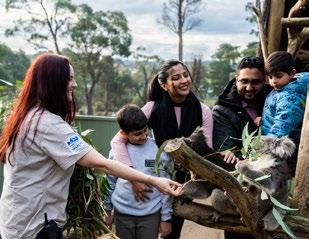
After all that exploring, you’ll have worked up an appetite. Ballarat’s dining scene has something for everyone, including vegetarian-friendly options. If you have little ones with you, try Lilly’s at Eureka for Goldmine Pancakes or grab a slice at The Forge Pizzeria. And for dessert, II Piccolo Gelato is a special treat.
As the day winds down, you might find yourself reluctant to leave – and why should you? Turn your road trip into a weekend adventure. Family-friendly stays like Quest Ballarat Station, BIG4 Ballarat Windmill Holiday Park and Sovereign Park Motor Inn, making it easy to extend your stay.
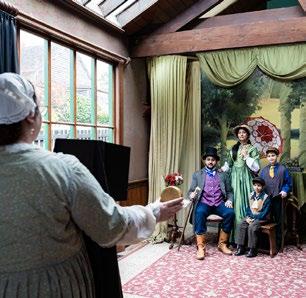
From Melbourne, take the Western Freeway (M8) west towards Ballarat. Regular V/Line services run from Southern Cross Station to Ballarat Railway Station. Either way, the journey takes around 90 minutes.
To plan your perfect autumn escape to this golden city, head to visitballarat.com.au

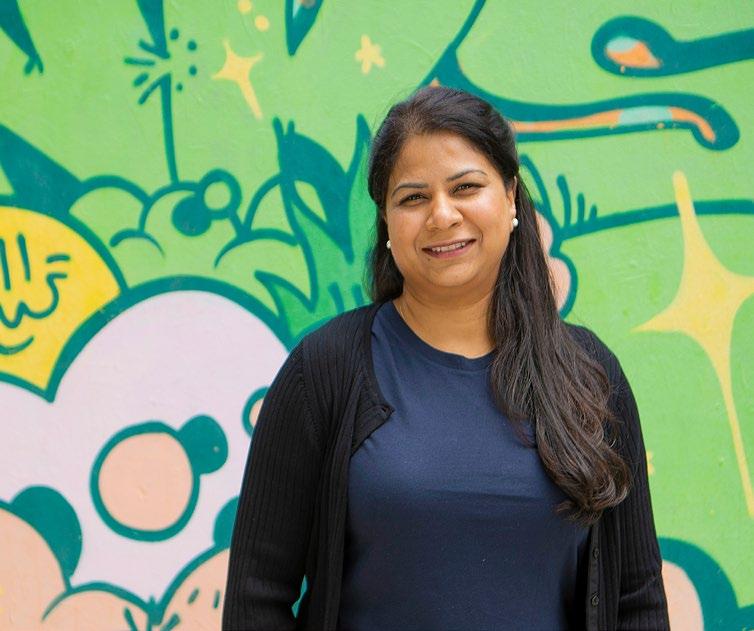


PUBLISHER
Pawan Luthra
EDITOR
Rajni Anand Luthra
CONTRIBUTORS
Lakshmi Ganapathy, Khushee Gupta, Torsha Sen, Sruthi Sajeev, Tarini Puri, Ananya Thirumalai, Frankey Gerard Fernandes, Apoorva Tandon, Sajit Nair, Anu Shivaram, Sumathi Krishnan, Sandip Hor, Minal Khona, Bhumika Srihari, Auntyji
SALES AND MARKETING
Charu Vij
GRAPHIC DESIGN
Shailesh Tinker
Indian Link is a monthly newspaper published in English. No material, including advertisements designed by Indian Link, may be reproduced in part or in whole without the written consent of the editor. Opinions carried in Indian Link are those of the writers and not necessarily endorsed by Indian Link. All correspondence should be addressed to:
INDIAN LINK MEDIA GROUP
Level 24/44 Market St, Sydney 2000 GPO Box 108, Sydney 2001 Ph: 02 9279-2004
Email: info@indianlink.com.au

IBY PAWAN LUTHRA
n 1945, as the world emerged from the devastation of World War II, the leaders known as the Big Three - Winston Churchill, Joseph Stalin, and Franklin D. Roosevelt - gathered in Yalta, Crimea. Their goal was to delineate postwar spheres of influence across Europe. Each leader sought to safeguard their national interests while simultaneously striving for a broader objective of global peace.
Fast forward to the present, and we see a new set of powerful authoritarian leaders shaping international relations with little regard for humanity or global welfare. Since taking office, United States President Donald Trump has approached global affairs with an assertive style, ready to redefine the dynamics of power on the world stage. Critics may label his methods as erratic, yet there may be a strategic rationale behind his actions.
President Trump assumed the presidency as the 47th leader of the US, backed by a Republican Party that controlled both Houses of Congress and secured the popular vote. This unprecedented political advantage grants him significant authority, at least
until the next elections for the House of Representatives.
In parallel, two other global strongmen, Chinese President Xi Jinping and Russian President Vladimir Putin, maintain firm control over their nations. All three exhibit scepticism toward institutions like the United Nations, believing that such multilateral organisations often hinder effective global governance. Within his first month in office, Trump withdrew the US from the World Health Organisation (WHO), threatened to cut funding to the UN, joined Libya, Yemen and Iran in not being a part of the Paris Climate accord, and dismantled USAID, endangering lives of millions globally.
Currently, a fragile ceasefire exists between Israel and Palestine, while ongoing discussions aim to halt hostilities between Russia and Ukraine, with the US acting as a mediator. The upcoming 9 May marks the 80th anniversary of the end of World War II, and should Trump successfully facilitate a peace agreement between Russia and Ukraine, he may receive an invitation to join Putin and Xi at the military parade in Moscow’s Red Square.
This occasion could provide a platform to discuss a modern update to the 1945 Yalta Agreement, focusing on consolidating power among the three leaders. For example, China might gain greater leeway regarding Taiwan
and the South China Sea, in exchange for curbing North Korea's aggressive posture toward Japan. Russia could seek options to influence its former non-NATO states, thereby restoring its stature as a superpower, while the US would aim for increased flexibility in its relations with Canada and Greenland. There would be more emphasis on a ruthless pursuit of power rather than on fundamental human values.
From a US perspective, the priority is “America First”. Instead of investing trillions in managing global conflicts, Trump advocates for a bilateral approach to resolving international issues. This was evident in his discussions with Indian Prime Minister Modi, where he suggested India should address its issues with Bangladesh independently. Tariffs and trade restrictions may further allow the US to sidestep previous global commitments and arrangements with allies.
For India, losing ground to China in this evolving geopolitical landscape would be a significant setback. However, with its economy valued at $3.4 trillion, India is dwarfed by China’s $14.7 trillion economy. Australia, historically seen as a US ally in the region, might feel betrayed after serving as the “deputy sheriff” in the Indo-Pacific, prompting it to strengthen ties with neighbouring countries like Malaysia, Indonesia, and India.












































































































































































































































































































































Proudly honoured with 31 media awards, including four-time recognition as Best Publication.
Three decades of all things Indian. In Australia.


It’s a hurrah for Indian-Australian women yet again this year.
Rajni Luthra wrote: Congratulations Veena Sahajwalla, Sukhjit Kaur Khalsa, Samantha Pillay, and Sunila Shrivastava. Women of strength, each one of you!
Sunita Gloster AM wrote: Congratulations! Wonderful recognition.
Amit Dasgupta AM wrote: Well deserved! Each is an inspiration!
Swati Dave wrote: Huge congratulations to all of you amazing women!
Sheba Nandkeolyar wrote: Congratulations to each of these amazing achievers. Making all of us feel proud.
Dr. Samantha Pillay OAM wrote: Thank you. And congratulations to Veena Sahajwalla, Sukhjit Kaur Khalsa, and Sunila Shrivastava.
Mitu Bhowmick Lange wrote: Sukhjit Kaur Khalsa is a true blue unique star.
Vivek Bhatia wrote: Congratulations Sukhjit, on this wonderful recognition! Chak de phatte!
Gitesh Agarwal wrote: Congratulations Sukhjit Kaur Khalsa.
Very inspiring. Being a father of a daughter who has similar ambitions and talent, I feel really proud and hopeful about what can be achieved. Congratulatory messages came in also from readers Bhagya Shankar, Sue Advani, Tharini Rouwette, Dipti Pandit, Dr. Saba Nabi OAM, Naresh Mithaiwala, Shally Relan, Kirit Kumar Prajapati, Anjaly Gupta, Nandani Singhal, Maheshchandra Shah, Rupal Desai, Jayaraman Guruswamy, Urmil Mehta, Prof.Chennupati Jagadish, Amit Dasgupta, Lopa Parekh and Dr. Raj Khillan



THE AGE’S YOUNG CHEF OF THE YEAR 2024
PRUTHA CHAKRABORTY caught up with Melbourne chef Saavni Krishnan of pop-up restaurant SAADI and Manze Restaurant.
Robert wrote: Gun chef!
Mohan Achuthan wrote: Rice dumplings with tomato kombucha. Sundarkala noodles with pippies and tamarind broth. When I’m in Melbourne next… William Angliss Institute wrote: Congratulations Saavni - we are excited to see where your culinary career takes you next!
Nisha Sarna wrote: Love this: ‘Indian heritage, European techniques and Australian influences’.
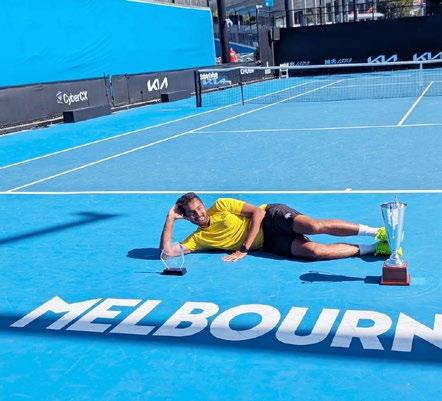
BHUMIKA SRIHARI spoke to India’s Prithvi Sekhar after he won the Australian Open Deaf Men’s title second year in a row.
Jyothi Krishnappa wrote: Enjoyed seeing this conversation, and learnt so much about how deaf players play. Prithvi was inspiring – best wishes to him for his upcoming games and for his career as a coach.
Prithvi Sekhar wrote: Thank you, Bhumika. That was a fantastic interview - I truly appreciated the opportunity to engage and interact.
@charan2516 wrote: What a champion. Wonderful interview.
@Sru2171 wrote: Good to see this interview.
@sriharid6995 wrote: Highly motivating for enthusiasts of this sport.
@s.vasanthi1125 wrote: So proud of Prithvi!
@kyunki08 wrote: Congratulations to Prithvi Sekhar, a wonderful achievement. Wonder what sort of support these unsung heroes get from the government or sports organisations. Do they get sponsorships?
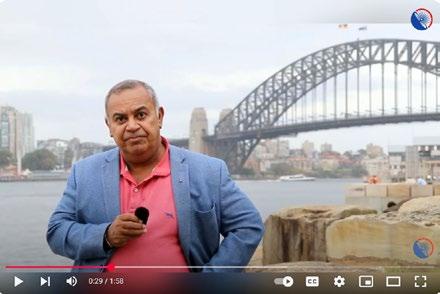
The oft-quoted ‘shared values’ notwithstanding, the contrast between India and Australia cannot be starker on 26 Jan. An episode from PAWAN LUTHRA PODCAST ahead of Australia Day and Republic Day 2025.
Margaret Santone wrote: So true.
Manoj Narsey wrote: Totally agree, Pawan.
Dinsha Palkhiwala wrote: Well said and summarised. One food for thought: Can the Indian subcontinent Australian citizens take the lead as catalysts to work out a common path between the two divergent views? We know what it feels like to be colonised, our constitution provides a case study of the solution, and we also know how a country without such shackles can prosper. There are huge similarities between Australia and India when it comes to language, ethnicity, and religion. Both countries have a lot to learn from each other. What better way to show our gratitude to Australia, our adopted homeland, than by finding a commonly acceptable solution to bring all citizens of Australia together as Australians first? Worth facilitating a conversation with a different perspective. What say?
Fotis Kapetopoulos wrote: Britain asked Australian colonies if they wanted to become independent, even a republic, in the 1840s. The colonies refused.






HASNAIN ZAHEER on visionary economist and former Prime Minister Dr Manmohan Singh, who shaped the future of modern India.
Sheba Nandkeolyar wrote: He was a quiet achiever.
Philip Ruddock wrote: Thanks. I had observed that he had passed away and grieve for him, his family and friends.
Rajni Luthra wrote: Nice to learn your personal parallels here, Hasnain Zaheer. Amazing how early influences continue to inspire. A great read.
Mahesh Enjeti wrote: Excellent article, Hasnain. Well-researched, wellcompiled, and well-articulated. I knew about Dr Singh's major reforms but not much else. Thank you for educating me. When you write, I read and I learn.
Abinash Dhungel wrote: A fantastic read.

SUMATHI KRISHNAN sat down with tabla virtuoso and ARIA award winner Bobby Singh, celebrated for seamlessly bridging the classical and contemporary worlds.
Margaret Santone wrote: One of the greats. Nilayan Sen wrote: Completely agree with Bobby about his pet peeve, the excessive ‘noise’ at performances. Many other performers have expressed the same frustration time and again. It’s not just disrespectful to the artistes who put their heart and soul into their craft, but also disruptive for audience members who genuinely want to engage with the performance. Also, it reflects poorly on the event organisers, who should ensure a respectful and immersive atmosphere. A little mindfulness from attendees can go a long way in preserving the integrity of the performance experience.
Shanti Raman wrote: A wonderful piece, Sumathi.
This stunning temple, known for its intricately carved pillars – no two alike – is a true architectural wonder.


RITAM MITRA crossed off a bucket list adventure recently as he trekked up to Everest Base Camp.
Sruthi Sajeev wrote: Okay I’m now torn - I’m definitely not the type to trek Everest but the pictures are dazzling!
Khushee Gupta wrote: Such an inspiring read. Trekking to Everest Base Camp sounds like the ultimate test of endurance and spirit - kudos to Ritam and everyone else who’s done it, for taking on the challenge. Adding this to my bucket list for sure!
Rajni Luthra wrote: Loved this piece - such stunning pics!! Hope Ritam Mitra recovered well: that last sentence sounded alarming.
Torsha Sen wrote: Looks like you had great weather. What an unforgettable journey! Trekking to EBC is no easy feat, but looking at the pictures, it's clear the mighty Himalayas gifted you with the most stunning views of Sagarmatha (Everest).
Bhumika Srihari wrote: I've heard trekking up mountains can be a life changing experience... These pictures speak for themselves. Kudos Ritam.
























You liked our Indo-Australian calendar for 2025.
Tarini Puri wrote: Just saw the e-paper, it has the 2025 calendar! Going to the shops to pick up my copy.
Shankar Raja wrote: Thank you for this, have been waiting!
Jessica Bhatia wrote: Wish you’d put this out in December each year instead of January…
Somnath Pathania wrote: How do I download a copy from your epaper?
This rural town was on the brink after a boom from hydro plant construction faded. With a clever tourism move, murals were painted on every building, transforming it into a thriving tourist spot and earning it the nickname 'Town of Murals'.


T“his is not only an honour and recognition, but also a call to action to do more,” says Dr. Samantha Pillay, who was awarded the OAM on Australia Day this year for her work in urology.
The Adelaide-based surgeon wears multiple hats, including that of an entrepreneur as well as an award-winning author and now even an AI film and music producer and director.
Dr. Pillay became the first Australian urologist to exclusively sub-specialise in Female Urology, Neuro-Urology, Functional and Reconstructive Surgery. Before this, she had been the first woman to complete surgical training in Adult Urology in South Australia.
Dr. Pillay has worked extensively with the medical fraternity to raise awareness about urinary incontinence and to end the stigma around the debilitating condition which, she believes, is still an underserviced field of medicine.
Educational resources on the subject developed by Dr. Pillay, including videos and lecture series, are accessed by thousands across the world, including the medical fraternity.
As a member of a raft of medical associations and advisory panels across the country, and as founder of Continence Matters, Dr. Pillay’s mission is to bring care and treatment to people of all ages with disabling bladder conditions, to build acceptance and understanding of these conditions by the wider community, to promote women’s health issues and

to support women as leaders as well as supporting programmes that help to empower women around the world.
Elaborating on her mission, Dr. Pillay says, “The emphasis in urology always tends to be around the prostrate, but
incontinence is a real issue too, affecting one in four adults on an everyday basis. Yet the topic is shrouded in secrecy because of stigma and embarrassment. I am striving to bring it out in the open.”
Her interest in medicine started
As a daughter of Indian Freedom Fighter J.L. Verma, Dr. Sunila Shrivastava OAM says serving the community has always

been in her blood.
“My father contributed significantly in the field of education: he established the Damor Degree College and was a founding member of Saugor University (now Dr. Hari Singh Gour University) from where I got my PhD in physics. That has inspired me to educate the young regarding our culture and heritage.”
Coming to Australia in 1973, the physicist retrained as an IT professional and spent nearly two decades with companies like Telstra and IBM. But once she retired, she felt compelled to support Victoria’s burgeoning Indian-Australian
early – fuelled largely by her own health conditions which required her to undergo multiple surgeries in her childhood. “I knew from a very young age that I want to be a surgeon and a specialist. I was fascinated by the technology being used in urology, but also attracted to it because it allowed me to perform surgeries and medical procedures sitting down, which was a boon for my own health conditions,” she shares.
She has also produced songs and videos highlighting the topic to make them more mainstream.
“Every single patient I see is an honour to be able to help on a day-to-day basis,” Dr. Pillay shares.
Outside of medicine, Dr. Pillay continues to be passionate about women’s affairs, particularly inspiring the next generation of female leaders. Her picture book series Inspirational Careers for Kids aims young girls to ‘Dream Big, Aim High’.
“I like to do things that make a difference,” she says.
Talking of her family, Dr. Pillay says, “My father was born in Malaysia to SriLankan parents. He came to Adelaide in 1948 and studied medicine at The University of Adelaide. He worked on the Holden production line and highway construction to support himself through medical school. He met my English mother while working as a doctor in Singapore. He then worked in Edinburgh, UK, where my eldest sister was born. He returned to Australia to work in Queensland, where my second sister was born, before returning to Adelaide, where I was born.”
A self-confessed workaholic, Dr. Pillay was the 2024 Women In Innovation Social Impact Award recipient and finalist for Telstra Best of Business Awards 2023 and the SA Australian of the Year 2022. She was also conferred the Urological Society of Australia and New Zealand Low-Arnold Award in 2024.
Describing what keeps her going and allows her to accomplish so much on a dayto-day basis, Dr. Samantha Pillay says, “I try to stay organised with lots of things-todo lists strewn everywhere. I wake up very early and do not watch TV at all.”
Tarini Puri
community, a decade long journey that would lead to an OAM.
“I thought ‘what to do next?’,” she remembers. “My husband and I both recite devotional songs and Indian epics like Ramayana, Hanuman Chalisa at various places. We decided, why not do it in a large group setting for all interested people? In 2008, we organised our first function to recite the Sundarkand Path –that was attended by almost 400 people.”
Thus began the Sankat Mochan Samiti (SMS), which has grown steadily into a non-profit in Melbourne’s south-east providing physical, spiritual and moral
service to the performing arts
Sukhjit Kaur Khalsa still remembers the pivotal moment she stood on the Australia’s Got Talent stage to perform her poetry almost ten years ago. Now, having just turned 30, and receiving an OAM for her services to the performing arts, she feels the same anticipation.
“It’s such an honour – I didn’t ever think that would be something on the cards for me,” she says. “Going on Australia’s Got Talent, that’s maybe the last time something like this happened, where you just get exposure.”
She adds, “I think being exposed to a bigger crowd or new audiences that don’t know about your work, that’s exciting. So maybe the OAM might bring out some new collaborations, some new supporters that I would have never had access to.”
With her first autobiographical book Fully Sikh just released, a culmination of sorts of the last twelve years of her career spanning spoken word poetry, theatre, arts management and music, Khalsa is in a reflective mood.
“I’ve had a lot of amazing, successful moments and they’ve reached millions, and I’ve had financial gain, but I think this book is something I’m proud of because it was scary. I hated the feeling of writing something and for it to feel permanent – I prefer it when you just put it out there to an audience [like live performance].”
“Maybe people hate it, maybe it’ll be a flop, but I think I like it. It takes a while as an artist for you to actually go: ‘What do I like?’ And if I enjoy reading it, then hopefully others will as well,” she says.
Of course, a decade in the arts as a woman of colour advocating for greater diversity is
assistance. Aside from cultural and spiritual education, their volunteers provide free meals, promote positive aging in seniors, upskill youth and welcome new migrants.
In 2014, Dr. Sunila Shrivastava helped establish the Sankat Mochan Kendra Indian Cultural Centre, a dedicated space for the Indian community in Oakleigh which she says is her most rewarding achievement so far.
“People wanted somewhere to sit in peace and meditate or worship – there was no such facility,” she says of the Centre’s beginnings. “Sometimes if I wanted to sit quietly for 20 minutes without the family or work environment, I would sit in the car before coming home from work, just to regain my strength.”

not without its challenges.
“I don’t know when I’ll be taken seriously… it sounds like such a whiny millennial thing to say, but I think I’m craving that, and I don’t know if in Australia I will,” Khalsa says.
“I think that early on in my career, racism and sexism bothered me; because I was putting such political stuff out there, I knew what I was in for. But now I’m not asking for big things. I’m not saying anything radical. I think I’m just trying to bring more people on the journey and I’m feeling a bit tired.
That doesn’t mean I’ll stop. But this is a good moment to reset and go ‘ok, what strategies can I use to have a sustainable arts career so I don’t destroy myself?’”
Nonetheless, she’s gleaned insights that are only possible with time, and from coming to her current role as the Executive Director of Perth’s Blue Room Theatre at a young age.
“When I was younger, the challenge was trying to convince my family and my community that I wanted to follow this path – that’s not a challenge anymore. Every couple of years you have new things to overcome, and lately I think because I’ve said
But perhaps her strongest contribution was as a leader of the SMS’s Hum Tum Task Force, where she could combine her interests in social impact and spiritual connection. Here, she has led many projects providing education on respectful relationships and support for those affected by family violence.
“At that time we were not even allowed to mention the term ‘family violence’, so we used to say respectful relationships, but gradually people are getting aware of these things,” Shrivastava remembers.
“In the taskforce we have specialists like lawyers, GPs, psychiatrists, social workers, all pro bono; generally speaking, when women go into these official services, they shift from one place to another – they haven’t got the resources
yes to such a big role at a young age without maybe going through some of the other steps, I’m now kind of going, ‘how do I make this work?’”
What hasn’t waned with time, however, is Khalsa’s deep passion for the arts.
“I want to stay in the arts forever, whether that’s in arts organisations or being an artist. I can’t see myself doing anything else,” she says.
“You forget this stuff means a lot, whether it is escapism or entertainment or whether it’s saying something and making change, all those stories and art experiences are important and will continue to have value in everyone’s everyday life. I think we just keep moving to the next goal [as artists], but we forget that we provide a space for people to reflect on life.”
Khalsa hopes to use the momentum from her OAM to continue to elevate the arts.
“I know that for some the OAM title doesn’t really mean much, but maybe for others it holds a lot of value, so I’m hoping that this elevates the arts even more and contributes to that cause,” she says.
or time, and sometimes they’re not allowed to come out of the house. We provide a one stop shop – you come to us, we listen to your problem, and then we ask what you want us to do.”
Shrivastava says she has unearthed a meaningful pursuit in the prevention of family violence.
“This is really our mission, that somehow, we eradicate this particular cancer from society. I know [there’s no] prescription remedy for it, it will take decades because it’s so deeply rooted in our blood,” she says.
Moving to Torquay during the pandemic, Dr. Shrivastava has since moved on from SMS. These days she and husband Arvind, who also holds an OAM, continue to bring peace to the
“I think that maybe I’ve grown up in a house where an award’s not really the end goal…your actions speak louder. But that doesn’t mean that awards still don’t hold weight. I think that they’re a great way to elevate people’s careers and gain new opportunities and maybe that might happen for me as well. But I also think that my actions also need to contribute to that. There’s still a lot of work I need to do.”
Though being an artist of colour in Australia is a wearying profession, Khalsa feels inspired to keep advocating for multicultural spaces.
“I would love to run an Australian Asian Arts Festival; in Perth, everyone lives so far [away] and it’s so isolated…the thing people keep sharing with me is that they haven’t found their community,” she says.
“I think I’m gonna be focusing on building that community over the next five years and kind of creating a space for people, wherever they’re at, to remind them we’re not alone and we can achieve more when we’re together.”
Lakshmi Ganapathy
community through Bhakti Tarang, where they hold devotional chanting sessions and celebrations for occasions like Karva Chauth and Janmashtami.
Going forward, Dr. Shrivastava hopes to keep healing the community and educating them on both family violence and Indian heritage.
“We have been given an opportunity to come to such a good place, one of the world’s best countries. In addition to the culture here, you should not forget our heritage,” she advises.
“I’m very thankful to the Australian government for recognising not only my services but the Indian community and all those people who believed in my objective and helped me carry out my objective.”
Lakshmi Ganapathy
For distinguished service as a member of an Australian ambulance service
Blaise Rego of Perth, a paramedic in the Ambulance Service, has been felicitated with an Australia Day Ambulance Service Medal (ASM) in recognition of his distinguished service.
“My first reactions were feelings of pride and honour,” Rego told Indian Link. “I was mostly appreciative that someone within my organisation thought highly enough of me to do the research of my accomplishments over the past twenty years, and take the time and effort to nominate me for this prestigious honour.”
Describing his work, he said, “As frontline employees in patient care, we undertake our duties without seeking acknowledgement or thanks, so to be recognised for my contribution to the ambulance service, and the legacy that I am able to leave for the next generation, is very special.”
Blaise Rego ASM has twenty years of experience in emergency clinical and operational response at St John WA, a charitable, non-profit, humanitarian
organisation, which for over 130 years, which has been servicing and operating as an integral part of the WA community. It teaches first aid and delivers the State’s ambulance service while also shaping and leading the sector nationally.
He has held numerous operational roles during this time, with lead positions in the development and implementation of several key internal programs and initiatives, such as the Paramedic Mentor Program, Event Health Services Bike Squad and Mangar ELK Safety Lifting Device.
Rego has assisted in several significant collaborations between St John WA, Royal Perth Hospital Cardiology, Fiona Stanley Hospital and Joondalup Health Campus that resulted in paramedic professional development, VEM (Virtual Emergency Medicine) implementation and RACE (Rapid Access Clinic for Elderly) support.
His passion for improvement also saw him involved in the PARTY (Prevent Alcohol and Risk-related Trauma in Youth) program.
Rego was an integral part of the success of the 2021 Metropolitan Management team pilot in the South West District, as well as a key contributor and administrator for the organisation-wide Leadership Interest Group.
“These initiatives required detailed business planning, budget management and collaboration with internal and external stakeholders to achieve organisational

objectives. These partnerships have led to improved patient care pathways and outcomes, as well as enhancing paramedic education and training,” Rego detailed.
As a highly qualified and experienced people leader, Rego has a proven track record in fostering strong, effective relationships with employees and external stakeholders.
Adept at driving change and continuous improvement through a collaborative approach, Rego is known for a peoplefocused, honest approach that emphasises leadership resilience and integrity.
“I am dedicated to supporting a team environment which consistently demonstrates the values of St John WA. This all leads to a team dynamic where operational excellence and high performance are at the forefront of my daily interactions at every level,” he added.
Blaise Warren Rego was born in
Nayantara Gupta, PSM
For outstanding public service in developing legislation for children’s rights and wellbeing.
For over four decades, Nayantara Gupta has quietly shaped the lives of countless children and families in Western Australia. This year, her remarkable dedication was honoured with the prestigious Public Service Medal (PSM), recognising her exceptional contributions to advancing children’s rights and wellbeing.
As the director of Legal Services and General Counsel for the Department of Communities, Gupta has been a driving force behind some of the most significant legislative reforms in the state’s history. From replacing outdated child protection laws to strengthening the role of Aboriginal families in critical decisions, her work has

left a profound and lasting legacy.
Gupta’s journey into public service began with a deep-rooted passion for social justice.
“I’ve always been drawn to addressing social issues,” she said, reflecting on her decision to study law at Monash University.
“I knew early on that I wanted to use my career to make a difference.”
Since joining the Department of Communities in 1995, Gupta has become a leading authority on child protection legislation. Her most notable achievement is the Children and Community Services Act 2004, a landmark piece of legislation that replaced laws dating back to the 1940s. “It was incredibly rewarding to bring those
laws into the 21st century,” Gupta shared. “For me, the most important part was giving children a greater voice in the decisions that shape their lives.”
Gupta’s work has also focused on addressing the systemic challenges faced by Aboriginal families in the child protection system. Through extensive consultations with Aboriginal communities, social workers, and legal teams, she helped develop policies that ensure these families have a greater say in decisions involving their children. “It’s about recognising their voices and their rights,” she explained.
Beyond child protection, Gupta’s expertise has influenced disability services in Western Australia, including her guidance during the Royal Commission into Violence, Abuse, Neglect, and Exploitation of People with Disability. Her ability to navigate the complexities of the legal system while prioritising the wellbeing of vulnerable populations has set her apart as a trusted leader and advisor.
Her achievements have not come without challenges. The process of modernising legislation is complex and time-intensive, requiring collaboration
Rangoon, Burma, now Myanmar. His family moved to Australia when he was 4 years old.
“My parents are Burmese but my heritage from my father’s side links back to Goa, India. I do not have a lot of history or memories from my grandparents as I was quite young when I left Burma and quite young when they passed away,” said Rego.
“In 1969, when my parents decided to leave Burma, it was uncertain times there, with military rule and political unrest. They decided to leave the country for better opportunities for the children. With 3 boys aged 6, 4 and 18 months, my parents managed to obtain a visa to Australia, and were sponsored out by the Catholic Church.”
“With just the clothes we were wearing and one suitcase each, we had to leave under secrecy – otherwise we would have been prosecuted by the military government. We landed in Australia to start a new life and with the charity and support of the Perth Diocese we were able to integrate into the Perth community.”
In his 20-year service, there have been many and varied challenges associated with being a paramedic, Blaise Rego ASM recalled.
“If I was to single out just one incident that was the most challenging, it would have to be losing a fellow employee in the line of duty. In 2023, Tinish Tamikodi became the first WA Paramedic to die while on duty. Even though I was not involved directly in attending this job, the loss of a well-loved co-worker, supporting the grief of his peers and the reality that we are all vulnerable while at work – were all extremely difficult to navigate for a long time.”
Frankey Gerard Fernandes
across multiple sectors. Yet Gupta remained steadfast, guided by a clear principle: the wellbeing of children must always come first. “Empathy is crucial,” she said. “Every decision we make has to prioritise what’s best for the child.”
Over the course of her career, Gupta has witnessed a profound shift in the way children’s rights are approached. She takes pride in reforms that empower children and families, including the introduction of employment screening laws to protect children from harm. “Seeing these changes take hold and knowing they’ve made a difference is deeply fulfilling,” she said.
Despite the accolades, Gupta remains humble, crediting the collective efforts of her colleagues and the community.
“I’ve been fortunate to work alongside so many dedicated people,” she said. “This recognition isn’t just about me — it’s about the incredible work we’ve done together.”
Nayantara Gupta’s legacy is etched into the fabric of Western Australia’s child protection system, a testament to her vision, determination, and unwavering commitment to the most vulnerable. Her work has not only transformed legislation but has also inspired a more empathetic and inclusive approach to policy making.
Ananya Thirumalai
For distinguished service to science as an engineer and inventor, to sustainable materials research and technology and waste management.
Professor Veena Sahajwalla is a renowned materials scientist, engineer, and inventor known for her groundbreaking work in sustainable materials and recycling science. She is particularly famous for developing green steel technology, which involves using waste materials like rubber tyres and plastics as alternatives to coal in steel productionsignificantly reducing carbon emissions. Her work extends to e-waste recycling, microfactories, green manufacturing, and circular economy innovations, making her a global advocate for sustainable industrial processes.
Prof. Sahajwalla is the Director of the UNSW Sustainable Materials Research and Technology (SMaRT) Centre at the University of New South Wales. She chats here with PAWAN LUTHRA.
Congratulations on your Australia Day honour, Dr Veena Sahajwalla, AO. Thank you, Pawan. I never thought I’d be referred to as that. I usually just go with Veena, so I'm really humbled and blown away.
But Veena, the National Museum of Australia describes you as Rubbish Queen. How does that title sit with you? Love it, love it, absolutely! Because it nicely captures in two words who I am and what I do. It’s actually a real honour, because it indicates I’m not afraid to take on difficult things. Rubbish is usually something that is cast away, hidden, out of sight out of mind. But I bring it front and centre, and talk about it as a valuable resource.
Growing up in Mumbai, you saw how everything was recycled to the nth degree. Does it make you angry, walking down the road in Sydney on Council collection day, seeing what people throw out?
It's scary. And sad. This whole throwaway mentality has taken us to that next level, where we can't even find a way to be able to share? Once it goes into the Council trucks, it's all going to get squashed up and scrunched up, and it's heartbreaking. So before the anger, comes that emotion of feeling really, really sad, for our planet. Mother Nature cannot take any more of this attitude of simply throwing

things away. We all need to make that extra effort to do better. We need to make our surplus goods and products and resources available to the broader community. There are so many good organisations doing amazing work, Salvos and other not-forprofits. We’ve got to stand up and do our part, individually.
Does affluence make us less inclined to recycle and by default, make us less environmentally friendly? We grew up seeing the kabaadiwalas, recyclers who turned our paper waste into everything from carry bags to bhutta wraps for our corn on the cob.
I think we ought to look at wealth as more than just about money. I think it should really be about how we cherish the environment around us. Preserving and protecting our environment, reflecting on it holistically, and feeling its impact deeply, are crucial in defining what truly matters to us. Those shared values are going to be important because if we're all going to be living on this one planet, it doesn't matter how much we have or don't have.
If we have enough to sustain life that is comfortable and care for our families and our communities, then that's how we should define (affluence) and say how lucky we are, and recognise that there are many, many people who are not as lucky as us.
Now, Veena, I believe your husband Rama walks behind you when you're out on Council collection night, so he can take some of this so-called ‘rubbish’ back to the house to recycle. What's the strangest thing you've actually picked up, and said, that's treasure, not trash? When I began my work using tyres to produce green steel, I remember picking up tyres that people had put out or thrown away. I’ve even gotten out of my car to kneel next to a discarded tyre, thinking who’s going to help me pick this up and put it in my car? (Laughs).
Yes, Rama is definitely there, making sure he's giving me a hand. I broke a coffee table at home recently, and he helped me clean up and pick every bit of tiny glass to be safely packaged and taken away for recycling. My amazing team at SMaRT do that
for example. These are essential products, but when they stop working, what do you do with them? Put them on your curb side. Imagine if it went into a microfactory. If it did get converted into plastic filaments, those plastic filaments were fit for purpose, and the purpose here is 3D printing, then we've created an ecosystem that basically challenges the notion that this is difficult to recycle.
But what's the trade-off between doing it with a socially friendly motive and the financial reality?
Well, this is why we've struck the right balance, which is working with industry partners – partners where the leadership is actively engaged, such as James at Renew IT. With Renew IT, we both recognise the value in the materials they collect: what kinds of plastics they are, can the plastic be converted into a viable product. Since we’ve identified filaments as our viable product, for use in 3D printing, then how do we actually go about converting those plastics into filaments. So we’ve done the science, they’ve done the translation of that science into practice.
too: everyone brings stuff in. One of my researchers this week brought in a masala grinder that had gone kaput. Over lunch it became quite the conversation - we can do this with the copper in it, this with the motor, and that with the wiring…
I can hear the passion in your voice. Tell us about the sliding door moment when you discovered the true passion in your life professionally.
I think it goes back to the kabaadiwalas you referred to earlier.
Growing up in India, I lived in a highdensity apartment building and as a sixyear-old, I’d yell out from my balcony to the kabaadiwala down below. Just did not care whether my parents approved or didn't approve of the fact that I’d be standing on a little stool to do this! I’d go, ‘I've got newspapers, I've got newspapers, come up and collect!’ The buzz from that was something I'll never forget. The people in neighbouring balconies would of course hear and stare and wonder why’s this little one so concerned, shouldn’t her parents be doing this?!
Who knew the kabaadiwala would be such a major influence! Wonder if he knows that little one’s gone on to invent microfactories. Tell us about these. We started working on this more than a decade ago. Microfactories are really about saying that - when we talk about waste as a resource and we talk about creating value - we have to be able to create products of use. Whether you've got small amounts or large amounts of different kinds of end-of-life materials, the important question, is what do you make from that is fit for purpose, and can you do it on a scale that is fit for purpose?
As a holistic system, microfactories are about the idea that we don't always have to have mega factories.
Yes, in some instances, mega factories are good at what they do at the large scale, and they achieve what we now call economies of scale. With microfactories, we look at also achieving economies of purpose. One example of a microfactory that has gotten up and running in 2024 is Renew IT, which takes in electronic waste. Your old printers,
If you’re in 3D printing, you can now buy 100% recycled filaments, right here in Australia.
And it’s all creating local jobs in Australia. When I say economies of purpose, I refer to the fact that our product is not only economically viable, but also good for the environment (for example where your industry partner is in the same city), and good for the economy.
Veena, you're a poster girl for women in STEM. Do you have any words of advice for them?
Thank you Pawan, for that very kind way of putting it.
Look, I’d just say, first up: recognise that there are always going to be challenges in life, situations you will run into where you’ll get told that this is not possible, that is not doable, it will never work, what are you thinking? There will always be the sceptics and the naysayers. Find ways to deal with them by getting your own inner confidence up.
Find mentors in your field or in your personal life who can give guidance and advice. You need to be able to say, I'm in the early days of my journey, or I've started a new venture, so I need some technical advice, or moral support. From your significant others, I think it's okay to find a shoulder to cry on –a husband or a partner to drive behind when you do strange things on the side of the road!
Veena, you've just been honoured with the AO, which also stands for Australian Open – the tennis tournament we’ve just concluded for this year. Last year 71,352 balls were used at the Australian Open. How would you recycle a tennis ball? I would first and foremost begin by asking, what's it made of? I'd need to identify the fundamental molecules in that fabric. I think I've got a solution or two up my sleeve, but I'd have to hold back on the answer till I've done an appropriate analysis.
Veena Sahajwalla, AO, congratulations on your honour. It's an honour to know you.
Thank you so much, Pawan, for that opportunity to share my passion with you today.

From winning his second consecutive Australian Open Deaf
title to championing inclusion in sports, Prithvi Sekhar proves silence is no barrier to success

I“BY BHUMIKA SRIHARI
It was my first ever press conference at the airport,” Prithvi Sekhar beamed as he recounted his return to India becoming the Australian Open Deaf Men’s Champion of 2025. “There was a huge crowd waiting to talk to me. My family ran to greet me. It was an emotional moment. Seeing their pride made all the sacrifices worth it.”
In the electrifying world of tennis, where the echo of a perfectly struck ball reverberates across packed stadiums, this champion carves his own unique symphony - one of resilience, grit, and silent determination.
Yet Sekhar’s journey to his second consecutive Australian Open Deaf Men’s Championship wasn’t easy.
“The tournament was tough,” he recalled. “Two new strong players joined this year, including my former doubles partner from Italy, who was the European Deaf Tennis Champion. He was a solid player and pushed me hard in the quarter-finals.”
His semi-final opponent Manino K was someone he had faced multiple times across different Deaf tournaments. “I had played him before in various competitions, and I knew he was a fighter. In the semi-final, I lost my first set. I had to sit down, close my eyes, and rethink my strategy. I knew I had to construct my points better. Once I reset mentally, I came back strong, winning the second set 6-3 and battling through a tough tie-break in the third to make it to the final.”
The final match was against French player Oliver Gray. “He’s a left-handed player, and lefties have a completely different style. But I stayed focused. The first set was 6-3, and in the second, he lost concentration while I maintained my pace, winning 6-1. On match point, I hit a downthe-line forehand winner - and that was it! I laid down on the court in pure joy.”
The difference between Deaf and Mainstream Tennis
“In a normal tournament, I wear my hearing aids, so I can hear the sound of the ball, the umpire’s calls, and even the crowd’s reactions,” Sekhar explained. “But in a Deaf tournament, all players must remove their hearing aids. That means I hear absolutely nothing - not the ball, the umpire, or the cheers from the crowd. It’s a completely silent game.”
While Deaf players have the same strokes, intensity, and pace as other professionals, competing in mainstream tournaments is a different challenge altogether. “The level of fitness, aggressive strokes, and game pace in normal competition is extremely high. Deaf players, while skilled, are not used to the same kind of relentless competition.”
Despite this, Sekhar has played in both categories and was ranked among the top 10 in India in 2023. “It has been an incredible journey - rising from a lower rank to competing at the highest levels in both Deaf and mainstream tournaments.”
The advantage and disadvantage of silence Sekhar acknowledged that playing in silence has its benefits. “Not being able to hear anything allows me to block out distractions
they deserve.”
He has seen first-hand how young Deaf athletes often lack guidance. “Many young players don’t even realise they can compete at a high level. They need better training, more exposure, and opportunities to play in both Deaf and mainstream competitions.”
In this regard, Sekhar made special mention of one of the toughest competitors in Deaf tennis - an ATP-level player from South Korea who competes in World Deaf Tennis Championships. “He is an extremely strong player, with a very aggressive game. Facing him in an international tournament would be a real test.”
Alongside playing professionally, Sekhar has begun coaching. “I want to train young players - both Deaf and hearing - and show them how to push themselves. I train in the morning, coach students in the afternoon, and hit the gym in the evening. It’s a full schedule, but I love it.”
His immediate focus is on the Deaflympics in Japan in November 2025. “My goal is to win gold in all three events - singles, doubles, and mixed doubles. I’m training harder than ever to make it happen.”
And as to the question about how Prithvi Sekhar would like to be remembered, the answer came after a moment’s thought: “As someone who inspired others. As a player who gave his best, no matter the challenge.”
Prithvi Sekhar is more than just a champion. He is proof that limits exist only in the mind. And as he steps onto the court for his next match, one thing is certain - the world is watching, and he’s ready to silence the doubts, one powerful shot at a time.
completely. I’m just focused on the ball, my opponent, and my game plan. There’s no external noise affecting my concentration.”
However, he also pointed out the downside. “In mainstream tournaments, players can hear the ball, the umpire’s calls, and even their opponent’s movement. That gives them cues on how to react faster. In Deaf tournaments, if a call is made and I don’t see it, I keep playing, thinking I’ve won the point - only to realise later that I have to replay it. That can be frustrating and mentally draining.”
The challenges of being a Deaf athlete
Sekhar spoke passionately about the struggles Deaf athletes face. “Many Deaf athletes struggle with communication. Not everyone knows sign language - I myself didn’t when I was younger, learning it later, piece by piece. And some parents don’t support their children in pursuing sports.”
He also highlighted the lack of tournament opportunities for Deaf players. “Deaf tournaments only happen once a year, whereas mainstream players get to compete every week. That’s why I push myself to play in both categories. We need more visibility and support for Deaf athletes.”
A call for greater inclusion
Prithvi Sekhar strongly believes that Deaf athletes should be given more opportunities to compete in mainstream tournaments. “The government and sports bodies need to see that Deaf players can compete at high levels. If Deaf athletes are only allowed to play in Deaf tournaments, they won’t get the recognition



The Mahindra XUV700 AX7 and AX7L are both exceptional SUVs, offering premium features and powerful performance, but they cater to slightly different preferences. The AX7 is designed with a focus on core functionality and comfort, featuring advanced safety technology, a spacious interior, and a sleek design. On the other hand, the AX7L takes things a step further, delivering additional features such as a blind view monitoring, premium 3D Audio with 12 speakers and 360º Surround View. Both the XUV700 AX7 and AX7L delivers Andoird Auto and Apple Car Play, a Panoramic SkyRoofTM and Advanced Driver Assistance Systems.Whether you’re seeking a practical, high-performance SUV or a

model packed with all the added features, Mahindra has you covered.

There’s never been a better time to own a Mahindra, with $3,000 off 2024 modelsduring the exclusive run-out sale! This incredible offer allows you to drive home in one of Australia’s most featurepacked SUVs at an unbeatable price. Whether you choose the functional and stylish AX7 or the luxurious AX7L, you’ll be investing in an SUV that delivers outstanding value, cutting-edge technology, and performance. Stock is limited, so don’t miss this opportunity to upgrade your drive and save big. Visit your local Mahindra dealership today and experience the difference!


Police are out day and night to keep everyone in the community safe.
If you break the law while driving, you could receive large fines and lose your licence. Don’t take risks while driving and follow the road rules or chances are you will be caught.


CEO
on how far
we’ve come as a multicultural society, and the new challenges that currently face us
Joseph La Posta, during your tenure as CEO of Multicultural NSW, you have spent time with people of many different countries, faiths and cultures. What have you learned about your fellow creatures?
That is a great question to start on, because the vast majority of people that I've worked with, all want the same things. They all want prosperity for their family, and to feel safe. By and large, they are very focused on the education of their children. Many people I get to work with, Pawan, are like you, migrants that have come here and are seeking to create the best life they can. As a consequence of that, they often have very high standards for themselves and their families in terms of how they conduct themselves. And they want nothing more than to be part of a thriving society where everyone can achieve its fullest potential.
So all is good, unless it goes wrong. What makes it go off track?
One of the things that's become increasingly
apparent over the seven years that I've been in the role, is how connected we are as a society. More than ever, we are consuming news coming directly through to our pockets, in terms of the devices we carry. I think back to when my family migrated to Australia from Italy, the only way they could consume news from Italy was through a very large satellite dish that was arguably, probably not erected with council approval, but which connected them to one or two television stations back in Italy. Today all of us can consume our media (so much more directly). And because of how the algorithms etc are constructed, that has a significant influence in terms of the material that’s directed to us. And in a society like ours, where we're trying to connect people to a common bond or purpose, whether that be the laws or the values of this country, that's an increasingly challenging job. Because people are exposed to different perspectives, sometimes polarizingly different. Our job is to try and bring those views together so they can exist harmoniously in NSW.
It's been 50 years since Prime Minister Gough Whitlam referred to Australia as a ‘multicultural nation’. If you had to write a 50-year report card for the former Prime Minister, what would you list as three achievements, and three items still to do?
That is such a fascinating question. NSW, with a population of roughly 8 million people, now has almost 1 in 3 of us born overseas, more than 1 in 4 of us who can speak two or more languages, and 1 in 2 of us with a parent born overseas. This means that if we didn't go through Gough Whitlam and that multicultural experience and openness, Australia wouldn’t exist today in the form that we're accustomed to. Because the reality of the situation is, and I think it was Arthur Caldwell, the Immigration Minister in 1945, who said to Parliament, we either populate or we perish as a society, because we don't have the birth rates to sustain our population. And that's increasing today - the average woman is having somewhere between 1.6, 1.7 babies. It's just not enough - we have to
complement our organic population growth with immigration and migration. And I think that's profoundly been a positive.
Second, if you look at our society, some of the most interesting and iconic physical and social constructs have come from our migrants. You think about people like Harry Seidler for example, and some of our buildings, the construction companies that have come here. Even today, businesses like Deicorp for example, are founded on migrant roots and heritage, which they've contextualised to Australian society and done incredibly well. The fact that we've allowed so many migrant businesses to flourish and to exist is a great strength and has only helped boost our economy. And third, when we get it right and we create the right frameworks for our young migrant families. We have doctors, heads of industry, professionals flying around the world, sharing their best practice from their education. The talent that has emerged from this social experiment of being a multicultural society has meant that we're probably the best innovators in the world.
The three things that will be our handbrake are, one, we start seeing difference or diversity as a negative. There's a particular rhetoric at the moment as we head into elections, about shutting borders, lowering international students, closing our minds to immigration. Of course, it's a balance, but we should never close it.
Second, it is very easy for us to accentuate our differences. And that's why we need a collective discourse that reminds people that it's okay to have different opinions, but it's not okay to ever breach the Australian law, and also be collectively responsible for what it is that binds us in terms of our shared existence here and the values of this country.
Third, when things go wrong, such as the pandemic, we're very quick to blame others for that. And that can manifest in terms of hate and racism. We're seeing some of that in our society today. When people are, they're looking for others to blame. We can never go back to a space like Germany of the ‘30s and ‘40s, where we go through tough times and we blame a group of people that are different from ourselves.
Are we having enough conversations about the positivity of multiculturalism?
No.
Why not?
Because I don't think positivity sells in the media landscape. And that’s a challenge for us. I think also, the challenge for many social justice and social agencies is they're so focused on turning the lights on their very existence, that they're not focused on how to uplift those small voices and really project them beyond.
Now Joseph, Meta has announced that they're removing the fact-checking options on their platforms. Elon Musk of X has stated that free speech is the bedrock of society. Meanwhile, ASIO has warned about the rise of far-right elements as a result of these changes. How can we balance freedom of speech with protecting individuals from harm? That one's well above my pay grade. With Meta my understanding is the fact checking is still there until the end of this year. It’ll be interesting to see what content is then allowed. From a personal perspective, I have hopped off X. I really enjoyed being on it - it was a great way for me to share some of the successes of this and previous jobs, and connect with different people. I began to find there was so much content that was really unsettling. And that content just seemed to feed and feed. But look, you've got your individual obligation to yourself. You can't rely on companies and how they behave to guide how you behave.
Can this not make your job as CEO of Multicultural NSW more difficult, with the current divisions in society, and people believing in things they want to believe in, rather than having rational discussions?
That's why it's so important that you have an education (that guides you to) consume divergent media sources. If I want to understand an issue on say challenges in a different part of the world, then it's not incumbent upon me just to go to one media source and use that as the source of truth. How can I get potentially different
perspectives that will balance my view? That requires considered effort. I think it's also about having trusted media sources and media partners. With respect to Facebook, I don't think it was ever invented as a media platform or source of truth. Sure, there are humbling and touching momentsbetween friends and family - and that’s a tick. Equally, there's a lot of negative on there - you only have to see some of the posts that your outlet puts up that are very balanced and people will shout at you through the comments. I believe it's incumbent upon us to acknowledge that freedom of speech should have limitations and barriers. We're having this very conversation at the moment at NSW Parliament about race hate laws and so forth, about what constitutes hate speech and where do we draw the line in terms of freedom of speech versus hate speech. It's going to be an interesting debate for our politicians.
As the CEO of Multicultural NSW, do you believe the hate speech laws - as they are - go the distance to be effective, or should they be tighter?
Well, the Premier's been really strong in his view on this. He believes that some of the actions that have occurred in recent months have not happened in a vacuum, and have started as a hate speech narrative that has evolved into people acting out on the hate
months. As a society right now, that's the part that's being tested - our ability to want to listen to different perspectives. Now that is incredibly hard at the moment. Right now, if you’re a member of our Australian Jewish community, you feel incredibly threatened.
I was incredibly proud of our Hindu community, the Turkish community, Chinese community, and others that extended themselves to say, right now you are a brother and sister. Your faith is almost inconsequential, and we won't tolerate people that are trying to divide us as Australians over our different faiths or our different cultures.
The internationalisation comes through, Joseph, as we just touched on. We’re all aware of the situation. Do we need to be more vocal in assuring our communities - of whatever faith - about the virtues of a multicultural state and the beauty of our cohesive society over here?
Your point's well-made there: what’s your obligation and responsibility if you're a local or a state member of Parliament?
Your local or state responsibility is to unite people across their differences. It's not necessarily to weigh in, to say a two-state solution or a one-state solution's right, or Donald Trump's right. It's to say to the
“When things go wrong, such as the pandemic, we're very quick to blame others for that. And that can manifest in terms of hate and racism. We're seeing some of that in our society today. When people are doing it tough, they're looking for others to blame. We can never go back to a space like Germany of the ‘30s and ‘40s, where we go through tough times and we blame a group of people that are different from ourselves.”
instilled in them. I can understand why he has that position. In terms of whether the laws go far enough, in any law you'll have people that say they're going too far, and other people that say they're not going far enough. The other challenge with laws is you need to make sure that they're a law that can govern for all of society and not just for a moment in time.
In the last 18 months there has been a rise in antisemitism. International and local events and the amplification of hate speech through digital platforms, have led us here. In a state which is proud of its multicultural fabric, how has this issue gotten so much out of control?
I think emotion is overriding how people behave. The challenge for us today is when we're constantly exposed to media sources that are looking to bring out or stir emotion, then we need to be really mindful that it doesn't govern how we behave. I think some of the members of our society have consumed overwhelmingly, incredibly negative and disturbing media in the last 18
their arms around both sides? Again, your point is a fair one, Pawan, but the challenge right now is, you've got a community that's received unprecedented levels of threat and attack. It's the responsibility of the government to meet that, to deal with it in terms of the full strength of its law enforcement, try and reassure that community to feel safe and not isolated. It's only a matter of time, Pawan, before you see a narrative shift. Once that community feels safer, it’ll then be about bringing everyone back together, encouraging those intercultural, interfaith relationships and trying to unite more people.
What do you see as challenges for Multicultural NSW, and yourself, in 2025?
I think overwhelmingly people are trying to make the dollar stretch further than they ever have before. The reality is, once people start to have less financial burdens and pressure on them, interest rates, inflation, these sorts of things start to regulate, people will start to open up and remind themselves that we're actually pretty lucky to live in Australia. Of course, there's times where we're doing it tough but we are blessed to live where we live. Look at the quality of our living standards and our ability to even have interesting, democratically different conversations like this one – that’s a luxury in other parts of the world.
I also think there's a part of our Australian psyche right now, that we’ve got to look after each other. I believe we as citizens also need to show a sense of internal humility. That is particularly problematic when you're coming into an election cycle where the parties are trying to endear themselves to groups and voters.
Do you expect these elections to be polarising? More so than before?
people here, that the people there, are their mothers, their children, their fathers, their daughters, their cousins. Where is our collective compassion and care for people regardless of what side of the border they’re on? Why is something that happens on one side of the border okay to you, but if on the other side, it's not okay? It's not necessarily about having a view in terms of foreign politics - that's for the Commonwealth government; it's more about our local and state politicians reminding people of the differences that's here and now.
Our Jewish community's been here for over 200 years. It's incredible, the contribution they’ve made to our way of life. I don't think we can lose (sight of) that right now.
There's members of our Palestinian, Arab and Middle east communities that are also suffering. And showing care and compassion to either of those sides shouldn't be seen as a negative, in my opinion.
I agree. Don’t you think the government needs to do more, to put
I love you asked this question because we as an agency have an obligation to write a report to Parliament each year on the state of community relations. And one of the headlines of our report last year was how democratically respectful Premier Minns and former Premier Perrotet debated that last election. And it honestly came down to policies, and to your personal preferences in terms of the leaders. But the way they respected each other and their families - they actually reinforced that they liked each other - that's the sort of democracy I want to live in. Not a democracy that's trying to divide us on Freudian slips when we know full well that person means the opposite to what they might have said under pressure, a democracy where we're trying to make the smallest voices even smaller and push them down for our own self-interest. It's important for the community to see political leaders for who they really are. While their actions might give us a sugar hit for a short moment in time, we need to remember that, as a society, staying united and working together is what truly matters in the long run.
Thank you, Joseph.

Use this QR code to watch the full interview on your phone.



IBY KHUSHEE GUPTA
f you’re a South Asian person, you can probably guess why Alok Vaid-Menon calls their show “Hairy Situation”.
“I've been a hairy person my entire life!” Alok admits. “People have always made fun of me or commented on my body hair. And then I thought about how the situation right now for trans people in the US is a hairy situation, meaning thorny, vexed, complicated.”
In bringing these two ideas together, Alok crafts a show that is both deeply personal and politically urgent. “It’s a show about body hair, yes, but it’s also a show about being trans in a world that doesn’t want us to be there. And what I’m trying to do is use comedy as a way to explore what often can feel like shameful or painful experiences.”
Alok Vaid-Menon is bringing their unique
Alok Vaid-Menon, a comedian and activist, explores themes of body image, transphobia, and gender identity through humoUr in their thought-provoking show 'Hairy Situation.’
It’s clear that for Alok, humour isn’t just entertainment - it’s a survival mechanism.
“I really always try to make fun of myself because I’m a water sign, which means that I feel emotions so deeply. If I allow myself to feel too fully, then it’s off the deep end. So humour is such a great way to keep me in check.”
Alok’s tour comes at a time when trans rights are under direct attack in the United States. President Donald Trump has announced that his administration will recognise only two genders - male and female - effectively erasing legal recognition for trans and non-binary individuals. He has vowed to end transgender rights in the military and in schools, and has already signed an order barring trans athletes from women’s sports, calling these policies a step toward the "Golden Age" of America.
Alok shared their fears and frustrations about this growing wave of transphobia.
“Here’s the genuine truth. I have no idea what the future has in store for us. It feels really nice to be outside of the US for a while, because I think there’s a lot of palpable fear.”
Indian and trans, and I can re-source those histories to understand that my communities have survived impossible conditions and found ways to be resilient in the face of incredible adversity. And so, I don’t have fear that we won’t make it through this. I think that we will.”
Born into a family steeped in literature, activism, and academia, Alok grew up surrounded by knowledge and artistic expression. Their grandfather Krishna Baldev Vaid was a playwright and novelist, their aunt Urvashi was a trailblazing LGBT rights activist, lawyer and writer, and their mother, Jyotsana is a psychologist. These influences shaped Alok’s creative and intellectual journey, paving the way for their bold and thought-provoking work.
Touring internationally, including their visit to Australia, provides Alok with a reminder of the global nature of their community.
blend of comedy, identity, and activism to Australian stages this February, with their show "Hairy Situation" touring all major cities from February 13-26. From Perth to Sydney, Alok’s performances promise a mix of hilarity and hard-hitting truth, exploring themes of gender, body image, and belonging. As a gender non-conforming artist, writer, and comedian, Alok has built a career on challenging norms while making audiences laugh and reflect.
As for the hairiest situation they’ve ever been in? Alok recalled a humorous yet stressful moment while performing in Kampala, Uganda. “I got locked in the bathroom! It was in the middle of a community barbecue. So everyone was outside celebrating and I was shaking the door, trying my best to get out. I didn’t have my phone. No one was hearing me because the music was blasting.”
After eventually kicking the door open, Alok acted as if nothing had happened. “I don’t mention it. I don’t tell anyone,” they laugh.
They continued, “We have no idea if these are going to be contested in court, if this is going to give more permission for people to attack us in person, because it was never about the law. What this is, is state-sanctioned transphobia, which gives permission for vigilante violence. So now, in so many ways, people feel emboldened to come and physically intimidate us and harass us.”
Despite the uncertainty, Alok remains hopeful. “I come from two communities who have long histories of resistance, both
“I’m really looking forward to remembering that the community that I’m a part of is not defined by my country of origin or by my gender or even by my race. It’s defined by people who dream of a better world. And that’s what I genuinely feel when I do my shows all across the world, is the people in my crowd are such generous, kind, compassionate, open-hearted people. And I think seeing one another in that crowd gives people hope, too, because the news can feel so alienating and painful right now.”
As Alok takes the stage across Australia, they bring with them not just laughter, but a vital message of resilience, self-expression, and the fight for equality. "Hairy Situation" is more than just a comedy show - it’s a testament to survival and the power of joy in the face of adversity.
“I come from two communities who have long histories of resistance, both Indian and trans, and I can resource those histories to understand that my communities have survived impossible conditions and found ways to be resilient in the face of incredible adversity.”

BY KHUSHEE


Dom and Ben met on Tinder, with Dom initially thinking Ben was “too good to be real.” What started as casual dating soon turned into something deeper, and after a year, they officially committed to each other and have been together for almost 8 years.
What does love look like for you?
Dom sees love in Ben’s generosity, kindness, and unwavering careespecially during difficult times.
“After my recent surgery, I was in a vulnerable situation, and Ben really showed how much he loves me. He was so caring and kind. It’s these things that you would expect a partner that truly loves you to do, and I think that's what love is for me.”
Ben, on the other hand, values
how much he learns from Dom every day. “This has been my most serious relationship and I think what's come out of it the most is the deeper understanding of each other and really just learning together.”
The hardest part?
For Dom, family acceptance was initially difficult. “Certain people in my family didn’t understand what a queer relationship could look like. Ben was often referred to as ‘my friend.’ My grandmother fully accepted Ben from the start, no explanation needed. People need to understand that this is not something you're familiar with and this may not be something you see every day, but it exists. Queer people often find themselves doing that.”
Ben acknowledges that queer relationships often come with external challenges. “Across all queerness, acceptance is a challenge. We're not here to change anyone else's views, but we're here to show that this is our love, and this is who we are. That's really the hardest thing, challenging and understanding other people's views.”
Advice for young queer people? Love requires learning and compromise. “We think that you really need to be true to who you are and not try and fit in a box when you're out there because even though we started dating eight years ago, it was still challenging back then. It really comes down to not rushing it, taking the time.”
Kashif and Danny also met on a dating app, a story familiar to many queer couples. Their first date wasn’t just about small talk; they dove straight into deep discussions on faith, family, and their future. They’ve been together for almost two years.
What does love look like for you?
Kashif describes love as the small, everyday affirmations that remind him Danny is his person. “For a long time, I was fantasising that my love was going to be like Sridevi and Rishi Kapoor in Chandni, or Shah Rukh Khan and Kajol in DDLJ. But now in my late thirties, I realised love was not by any means the definition I had in mind. Two years on, every single day, something tells me that he’s a
beautiful person in him so much.”
For Danny, love vulnerability. “To let you fully is a risk, especially men who haven’t always full acceptance from community. I think practical and it requires It's about also being
The hardest part?
For Kashif, navigating expectations and community pressures remains a three sisters who are They share their lovely, straight, married lives groups for the family to do that because people off in certain

BY KHUSHEE GUPTA
As Sydney gears up for its annual Mardi Gras celebrations - a celebration of love in all its forms, many South Asian queers find visibility and representation are still evolving. Stories like these are powerful reminders that love, in all its beauty and resilience, deserves to be seen, heard, and celebrated. Let’s remember that love, unapologetically proud - has always existed and will continue to thrive.


my life, and I love is about let someone see especially for gay always experienced from family and love has to be requires negotiation. being vulnerable.”
navigating cultural community a challenge. “I have are already married. lovely, beautiful, lives on WhatsApp family and I don't get if I do, it may rub certain ways. So I keep it
very personal. We have to be cautious about what we share because there is still a lot of stigma around queer relationships.”
Danny highlights the importance of unlearning internalised homophobia.
“We have to unlearn the stigma and the internalised homophobia. Coming from strong cultural backgrounds, we’ve had to redefine faith and culture in a way that aligns with love, acceptance, and kindness rather than restrictions.”
Advice for young queer people?
Like Dom and Ben, Kashif and Danny emphasise communication, growth, and authenticity. “Stay true to who you are and your love. Don’t bend yourself to fit into outdated narratives.”
Suz first reached out to Sheetal after seeing her on TV discussing diversity, equity, and inclusion. At first, Sheetal didn’t think much of it, assuming it was just another friendly note. But everything changed when they started exchanging voice notes; hearing each other’s voice and perspectives on the world, they knew they had to meet. The two got married in late 2024.
What does love look like for you?
Sheetal grew up with a clear idea of love, shaped by her parents' arranged marriage. She believed that if two people were committed, they could build a love story after marriage and live happily ever after. But for her, that wasn’t the case. No matter how much she tried to "make it work" with men or other partners, it never did. That understanding shifted when
she met Suz. “When I met Suz, that understanding matured further and I finally felt like I had met a true partner; my partner. She was the perfect fit for me and the only thing I couldn’t do was try to find what couldn’t work!”
The hardest part?
Despite their deep connection, Suz and Sheetal, like any couple, face misunderstandings and disagreements.
“Especially as an interracial couple with different cultural frameworks! But we choose curiosity over suspicion, communication over silence and each other above all.”
As Sheetal began breaking some expectations, the rest seemed to lose their weight - at least to those around her. When she didn’t marry a brown man after her first degree and then crossed 30, the pressures
around marriage, children, and career started to fade. And once it became widely known that she was queer, those expectations nearly vanished altogether.
Advice for young queer people?
Sheetal is a big believer in doing what feels right and accepting what happens as a result. “It took me more than 10 years to bring my parents from a place of ignorance to acceptance,” she shares. While that may not be the case for everyone, or a safe option, she acknowledges we need to try and bring our family along and for her, it felt right to do that at the time, or at least try. “And I’m so glad I did.”
“Life doesn’t turn out how we expected; we can grieve that and simultaneously appreciate that sometimes it’s better than we imagined - and that’s okay, too,” she reflects.

… but looks like Gen Z may have switched off

PBY SRUTHI SAJEEV
er usual, the shops were awash with red and pink advertising around this year’s Valentine’s Day; slogans urged people to buy gifts for “him” or “her”, and people asked if you had plans for this day dedicated to love. But many people in my generation seem to have switched off – and didn’t really have that ‘special someone’ in mind. And the grown-ups have taken notice. Since mid-January there’s been an onslaught of articles about the so-called “relationship recession,” and the stats are surprising. Whilst there haven’t been many studies conducted in Australia, the Pew Research Centre found in 2023, that amongst the Americans who are single, 57% reported that they were not looking for a relationship. One of the main reasons for this was that it simply was not their priority. Similarly, the Financial Times found that globally, young people in particular, were less likely to be in relationships. It seems that those chance encounters in book shops and declarations of love on New Year’s Eve simply aren’t a reality for Gen Z. Let me assure you however, that I’m not bitter about this. In fact, I think that Gen Z (at least those who are middle class
and financially well off) truly enjoy their singledom.
Instagram, my lived experience, and plenty of late-night conversations with friends have given me insight into the psychology of your average, middle-class, South Asian Girl. She’s armed with an education, stable housing and has been told the tale of how it was decided that her grandma and grandpa were to be married way too many times. That last one always goes along the lines of “needed to for the money,” or “my family was worried about what others would say.” Lucky for us, we no longer live in this reality. In fact, with the internet at our fingertips, we have more opportunities than ever.
Want to start a business? There’s an online course on that. Want to learn a language? You can easily start with Duolingo. So, is it a surprise that the youth prioritise their personal growth?
And of course, my Instagram ‘for you’ page has influenced me big time. It’s filled with reels by stylish brown women with attitude, fearlessly embracing their solitude. They settle down in front of their cameras, drop insights on life whilst flawlessly applying their makeup.
Influencers like Twinkle Stanly dedicate a large portion of their content to advocating for this lifestyle. “I have my own money now, my own house. I’m thriving, happy, fitter and healthier because I have the time and mental space to think about myself…” she says in a reel.
Just don’t take a peek at the comments below these videos, where people who are clearly irked by her message, mock her for her appearance, decisions and even the way she speaks. Whilst some of these commenters are women, a majority are men.
Here lies the second reason that there are fewer heterosexual couples. There’s a growing disparity in the political ideals held by Gen Z men and women.
Whilst in Australia, this disparity is less prevalent than in other countries, it nevertheless exists. After analysing data from the Australian Election Survey in 2022, researcher Intifar Chowdhury found that 34% of Gen Z men voted for the Coalition. In comparison, only 19.8% of women did the same.
But I don’t need statistics to see the growing differences in political ideals along gender lines. I just need to enter a university class and listen to a debate on gender issues.
Whilst 2000s rom-coms continue to be all the rage, “meet-cutes” have become a rarity
Within five minutes, someone will ask a question like “well, what does verbal abuse even mean?”
But perhaps a more pressing concern than being separated by ideology is the physical distance that separates us. A discussion on modern dating is not complete without mentioning the age-old subject of COVID-19, and its effect of making isolation almost habitual. And being a university student does not guarantee a thrilling social life (case in point, if you walk into the Writers Club in Week 2, you’ll be lucky to find more than five people. Although maybe that’s because it’s the Writers Club).
So, because “meet-cute” is off the table, we must turn to online dating. I can’t recall how many times I’ve asked someone whether they felt safe on a dating app, only to be met with “no, but I want to keep trying anyways.” Their bravery is to be commended. As the industry codes for dating apps introduced by the Albanese Government are voluntary, not all sites adopt the same safety mechanisms. But these are all issues for future me to deal with. Right now, I find strength in my relationships with friends and family. And I’m old enough now that my idea of a “happily ever after” isn’t a Disney-style romance. So, this year’s Valentine’s Day (or should I say, Galentine’s Day?) I enjoyed my heartshaped box of chocolates with close friends while we watched movies and had a good old gossip session.
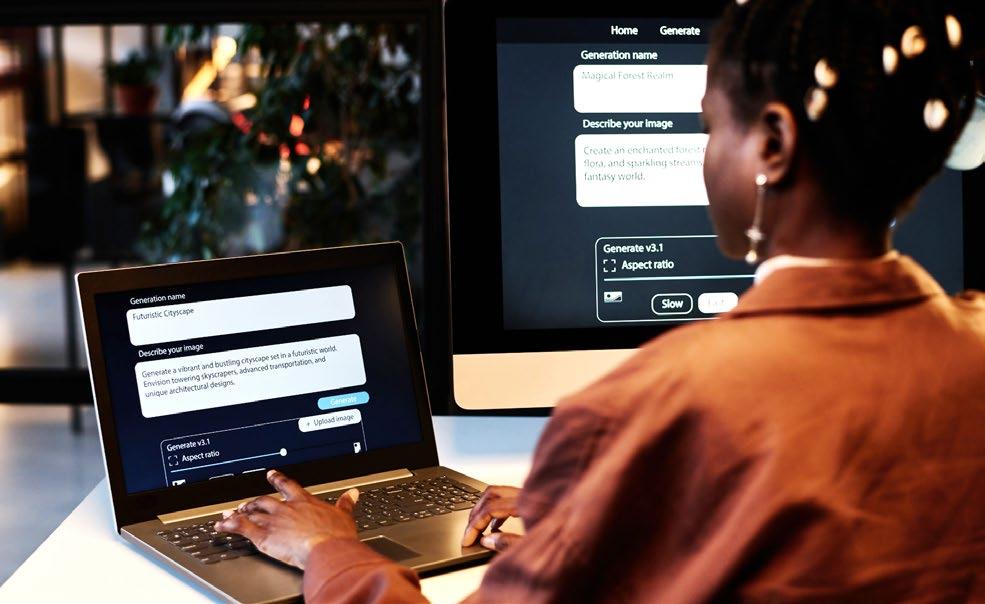

TBY SAJIT NAIR
he professional world is truly in the grip of “AI fever.” Every company worth its salt is talking about using AI to enhance its products and services or improve productivity and process efficiency. No pitch deck or planning report is considered complete without a generous sprinkling of AI-related buzzwords. Many of these companies promise a future where AI replaces human effort in the production of goods and services — an outcome that has left the modern workforce imagining all sorts of doomsday scenarios about the future of work.
Unsurprisingly, this has sparked anxiety among the white-collar workforce, often referred to as the “laptop class.” The current AI revolution is largely driven by ground-breaking advancements in a group of technologies known as Large Language Models (LLMs), the most famous being ChatGPT. These LLMs are trained on vast amounts of text data, enabling them to predict and generate meaningful text outputs based on the prompts they receive. This capability allows these powerful tools to write code, draft emails, create convincing sales pitches, and even produce high-quality poems, jokes, and stories.
In light of these developments, it is crucial for employees to future-proof their careers and make their roles AI-ready. While the impact of AI spans across job titles and industries, the most significant disruptions are currently seen in programming, legal

services, and customer care. This is because LLM-based applications excel at tasks involving language and text, thanks to their extensive training on text data.
Learn to use AI, especially prompt engineering: A common refrain among AI experts is that AI won't replace jobs, but employees skilled in AI will replace those without such skills. Technological disruption consistently replaces jobs without destroying them. Those who successfully adapt to these transitions benefit the most. Enrol in AI courses or integrate AI into your work.

Starting and persisting on the AI learning journey is the best way to ride the AI wave.
Develop skills like critical thinking and storytelling: Although AI is advancing rapidly, it still falls short of human capabilities in areas like critical thinking and storytelling. The modern workplace has long valued employees with soft skills such as analytical reasoning, creative problem-solving, and storytelling over those who merely complete tasks. This edge will become even more pronounced as AI commodifies many technical skills. By incorporating AI into your routine, you'll have more time to leverage these soft skills to meet organisational needs.
Shift to less repetitive, more strategic roles:
While the impact of AI spans across job titles and industries, the most significant disruptions are currently seen in programming, legal services, and customer care.
Repetitive desk jobs have always been prime targets for AI-led automation. Middle managers and department heads aim to improve team efficiency and cost-effectiveness, and AI offers the biggest productivity boost in years. Transitioning from repetitive, processbased roles to strategic positions requiring interpersonal skills can make your career more resilient to AI disruption.
In a gold rush, sell shovels: AI hype is at an all-time high, with 89.6% of company leaders planning to increase AI investments this year, according to the 12th Annual Data and AI Leadership Executive Survey of Fortune 1000 companies. A prudent strategy would be to join teams building AI applications or infrastructure for internal or external clients. Agentic AI, a rapidly growing subfield, involves developing AI agents that automate workflows — an area worth exploring to future-proof your career.
Embrace and adapt to AI: When used as a tool, AI can significantly boost productivity. For instance, AI coding assistants like Copilot have been shown to improve developer productivity by 27%, according to a study by economists from MIT, Princeton, and the University of Pennsylvania. When AI complements human skills, the results can be extraordinary. Employees with language barriers can now produce work on par with native speakers, and managers can complete presentations in a fraction of the time, freeing them to focus on high-priority initiatives. Leveraging AI can exponentially increase productivity and effectiveness, making it essential to embrace AI in your work.


ABY Dr NIDHI
s a paediatrician (especially one with a lifelong fascination with blowing bubbles and collecting stickers)
I understand how daunting it can be to know where to go to get accurate health and medical information. Some topics could be challenging to discuss freely within our South Asian community, and sometimes, the health advice we receive from health providers may not align with our cultural practices or values. The Bubs and Bubbles space is a safe area where you can find medically accurate, evidence based and culturally sensitive health information
Please remember, however, that this is general medical information and not specific to your child. If you have concerns, please book an appointment with your friendly GP and they can guide you to whether you need to see a paediatrician or another specialist.
We are starting the year off with a huge plug for preventative health. These ‘8 healthy habits’ can keep our little ones (and their parents!) in the best cognitive, physical and mental health space possible- and this means fewer doctors’ visits (apart from immunisations and general checkups). Let’s go through these in a bit more detail, and look at what goals you can set for the year ahead.

1. Drink Water
Prioritising water (and keeping soft drinks, juices and cordials as ‘sometimes’ drinks) is important, especially in summer.
2. Eat 5 serves of vegetables and 2 serves of fruit daily

One of the biggest challenges I hear for families is their struggle with eating! Reassuringly, improving variety of food takes time and it’s important to be consistent and start young. Having protected meal times (especially dinner) away from distractions (such as screens) is a good start. Continue to put a wide variety of foods on the plate, even if they don’t eat them at first. Luckily, our South Asian cuisines give us plenty of varied ways to cook vegetables, legumes and meats and therefore many different meal options!
Vegetarian/vegan diets can struggle with getting enough iron, but it’s not impossible! Green leafy vegetables, lentils, black beans, and some nuts are all very good sources. Many children drink too much cow’s milk - whilst small amounts (maximum 200ml per day for a child over the age of 1) are beneficial; in excess, this can lead to increasing your child’s risk of constipation and iron deficiency.
3. Start the day with a healthy breakfast

Try to prioritise foods which have a high protein content and are low in sugar. Eating in the morning is important to help regulate blood sugar levels and provide fuel to growing brains so they can learn well at school, especially after fasting all night!

4. Know your portion size
Kids are generally good at telling us when their bodies are full, but sometimes using a portioncontrolled plate can be helpful. Generally trying to eat the rainbow (lots of colours) is important; aim for half the plate to be full of vegetables (incl some fruit), ¼ plate protein and ¼ plate some form of grain and carbohydrate. You can use your imagination to see how the dishes you eat as a family can fit within these guidelines.

5. Choose healthier snacks & fewer treat foods
Takeaway is delicious (and a good break from cooking for mum and dad)! We would recommend no more than one meal per week, and this means chips and chocolates too!
6. Screen time
Screens can be a great way to learn and unwind, but too much screen time is not great for brain development or behaviour. Most of us use screens in the evening to relax, but there are lots of research papers which show that our brains aren’t actually relaxing in a beneficial way. This affects sleep quality and how well the brain works the next day. Excessive screen time is also linked to worse mental health outcomes. Aim to have all screen-based homework completed earlier in the afternoon, so that it’s easier to implement not having any screens (including TV!) for at least an hour before bedtime. If you feel that your child’s use of social media/gaming consoles/iPad is excessive, there are support services available.

7. Being active
This is a good reminder to keep moving, even when homework/assignments can start to pile up. Doing something that makes you huff and puff for an hour a day (even a brisk walk) helps improve the brains cognitive capacity. It’s also very important for heart health, and keeping preventable diseases like diabetes and heart disease at bay. In South Asian cultures, we are more at risk of these diseases and teaching our children the importance of movement early in life is vital.

This is the most important goal (and my favourite) to help optimise for families. Kids need more sleep than you think! Culturally, South Asian sleep habits can be different to those in the western world - typically our children often sleep later and less hours. This can impact their health and development in a negative way. It might surprise you to learn that an average teenager requires anywhere from 8 to 10 hours of quality sleep per night! Some sleep hygiene strategies that doctors will recommend include having a consistent bedtime routine after dinner, stopping all screens and devices at least an hour before bedtime, reading/engaging in some other calming activity before bed (like listening to calming music or an audiobook), and having consistent sleep and wake times (especially on a school night). If your child has fears/worries around bedtime, snores (with pauses in their breathing) or is struggling with their sleep routine, it’s important to see a health professional to explore this further This may all seem very daunting, but making small changes every day will soon mean that they will soon become an unconscious part of your daily routine!

Scientist and writer Dr. Sydney Srinivas’s latest book brings us the life and work of Marie Curie, the first woman to win the Nobel Prize

ABY ANU SHIVARAM
t the recent launch of Prof. Sydney Srinivas’ latest book Marie Curie, Ewelina Ellsmore, the Literature Coordinator of The Polish School of Sydney, wanted to know what he would ask the pioneering Polish scientist if he were to meet her today.
“I would not ask her anything, I would simply touch her feet,” Dr Srinivas replied, in his Indian tradition of showing respect.
It was enough to give the audience of three hundred people an idea of the absolute regard with which Prof. Srinivas holds Marie Curie, the first woman to win the Nobel Prize, and the only woman to win it twice.
The book Marie Curie: The first woman Nobel Laureate and a pioneering scientist (Prism Books Pty Ltd) is the latest in Prof. Srinivas’ series on great scientists like Charles Darwin, Isaac Newton, Albert Einstein, Srinivasa Ramanujam, Galileo and Alfred Nobel.
It tells the story of Marie Curie’s struggles and triumphs as a pioneering woman scientist working in a predominantly male world, and in a continent ravaged by World War I. That Marie rose through these challenges as a common citizen, and as a poor, struggling migrant in Paris, speaks volumes of her extraordinary aptitude.
Talking to Ewelina Ellsmore, Prof. Srinivas described his research for his books. Even though he had read biographies in his younger days, it was his visits to the homes and work places of the scientists to immerse himself in their worlds, that gave him the deep insights needed for his own books.
“These travels are like scientific pilgrimages for me. I could feel the presence, standing in Newton’s room, or being in Marie Curie’s laboratory.” It was clear that these trips moved him profoundly.
The book was formally launched by Prof. Jonathan Bland-Hawthorn, Laureate Professor of physics at the University of Sydney, and
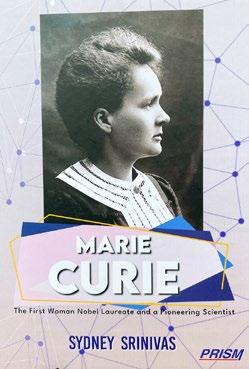
Director of the Sydney Institute for Astronomy.
Prof Bland-Hawthorn complimented Prof. Srinivas on his keen interest in bringing the lives of the great scientists to the common man in a simple, lucid style. That he explains the science in his books, beyond the life stories, was also laudable, Prof Bland-Hawthorn observed.
(The chapter on the discovery of radium, for example, introduces lay readers to the concept of radioactivity, captures the awe of witnessing luminous radium for the first time, details the process of announcing a new element, describes the laboratory equipment used, and highlights Marie Curie’s meticulous notes.
And did you know that the other element Marie discovered, Polonium, was named for Poland, her homeland?)
“Marie led a remarkable family – they share five Nobel prizes among themselves,” Prof. Bland-Hawthorn said, noting from the book that Marie and Pierre shared a Nobel Prize in physics and Marie was awarded a second one in chemistry, making her the first person in history to win a Nobel in two scientific disciplines. Her daughter Irène and son-in-law Frédéric JoliotCurie won the Nobel Prize in chemistry. Henry Richardson Labouisse, Jr., the spouse of Irène's
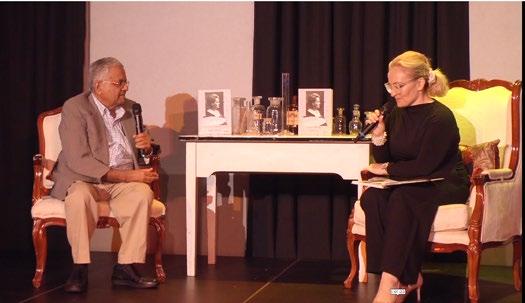

younger sister, Ève Curie, was awarded the Nobel Prize for Peace.
Helen Lyne, writer and spoken word poet, recalled her association with Prof. Srinivas at the writers’ forum where he had shared extracts from his manuscript. “He doesn’t describe Marie Curie as a feminist,” she said, “but I do, after reading this book.”
Prof. Srinivas details Marie Curie’s fight throughout her life to be accepted as a scientist. Women were not allowed to access university education in Poland, so Marie had to go to Paris for higher studies. There, she was treated as a poor migrant woman and had to fight the system to gain recognition for her work as a young scientist. Her name was included in the citation by the Nobel Committee only at her husband Pierre Curie’s insistence.
As a scientist Marie Curie was an early role model for women in STEM today. She may be an old stalwart, but as Rajni Anand Luthra, the editor of Indian Link pointed out, all the old masters have tremendous contemporary relevance. “We’ve seen in recent times the rise of a movement away from scientific thought,” she said. “We live in times when we should be reading more of the old masters who gave us things that we now take for granted.”
One unique aspect of this book is that it is simultaneously published in two languages, English and Kannada, Prof. Srinivas’ native tongue, spoken by 44 million people in the South Indian state of Karnataka.
“Kannada comes from my heart, English comes from my brain,” Prof. Srinivas has said many a time. Producing books like these in language can exponentially expand their reach, connecting with larger and more diverse communities.
Prof. Srinivas is well-known to Indian Link readers through his incisive reviews of Indian classical dance and music concerts in Sydney. He is also known for his fictional and non-fictional books, especially the life histories of great scientists.
The books for the launch were shipped with assistance from Qantas. Copies of the book will be available online at Prism books Pvt Ltd. The proceeds from the book will be donated to the McGrath Foundation.



ABY RAJNI ANAND LUTHRA
fter a full day at the ongoing Australian Spoken Sanskrit Summer School at ANU, student Jane reflected, “I’m enjoying the immersion in the language. The sounds resonate within like having a bath in love.”
Fellow student Ram agreed. “Sanskrita bhasham pathan mahat sukham anubhavami,” he told Indian Link. I feel great joy in learning Sanskrit.
Jane and Ram are two of a dozen students who have enrolled at the two-week program, coordinated by Dr McComas Taylor, Professor of Sanskrit at ANU’s College of Asia and Pacific.
“It’s the fifth such program we have organised,” Dr Taylor explained. “We run it as a community course, once every five years, with Dr Sadananda Das of Leipzig University. He’s well known in the Sanskrit world, and the most gifted teacher I’ve ever come across – he’s had the students feeding out of his hand.”

Sanskrit, an ancient Indo-European language of India, is the medium of Hindu scriptures and classical Indian epics, and the linguistic root of many modern Indian languages. It originated as early as 17001200 BCE, preserved as Vedic chanting tradition. It was around 500 BCE that Classical Sanskrit was born, when scholar Panini defined its grammar.
Although it is still used in Hindu rituals, and is widely studied and understood by linguists and academics, spoken Sanskrit is uncommon. But that is an idea Dr Taylor is happy to debate.


“You would believe (it is rare) if you weren’t a Sanskrit speaker,” he noted. “If you were a Sanskrit speaker, you’d know it is spoken all over India, not only in the religious centres like Varanasi or Pune. It is definitely more common now than it was ten or twenty years ago.”
While his own Sanskrit courses at uni might involve reading the texts from the Vedas and Upanishads and learning grammar, he sees the teaching of conversational Sanskrit as using the knowledge in a productive way.
“Spoken Sanskrit is actively using the
knowledge which would otherwise remain passive.”
The typical profile of the student in the course is someone who has had exposure to Sanskrit before.
“Our students are undergrads, retirees, yoga teachers, yoga practitioners, Hindus, Buddhists. This year they’ve come from all over Australia, and from Hong Kong. They have a curiosity about Sanskrit, and a desire to put passive knowledge about the language to active use.”
Only about a third are of Indian origin, and many are repeat students.
The course is promoted through networks of Indian students and Indian studies.
Dr Sadananda Das is quite pleased at how this year’s course has turned out.
“It’s been a happy time at Canberra,” he told Indian Link. “I’m quite overwhelmed. The students have been enthusiastic.”
The program sees the learners deeply engaged – with exercises in speaking, active listening, singing, storytelling.
Practice conversations are relevant and contemporary, such as daily routines, likes and dislikes, going shopping, watching the news on TV in Sanskrit.
A particular hit this time round, has been the telling of the story of Ganga descending from the heavens, recounted from an Amar Chitra Katha style comic.
While Dr. Das’s mainstream work at Leipzig University’s Institute of Indology and Central Asian Studies explores the rich literary and philosophical traditions of Sanskrit, his short community courses focus on its practical applications, breathing new life into the ancient language.
Having conducted Spoken Sanskrit courses some 52 times over nearly three decades, Dr Das has seen nearly 1500 participants thus far.
“There are four-week courses, or intensive two-week courses like the current one at ANU. I’ve been conducting them all across Europe – Heidelberg, Lausanne, London, Barcelona, Florence, and Berne. It is deeply gratifying for me that the participants are studying for love, for knowledge.”
He is thrilled with the feedback from the Canberra students: Fiona is happy to be able now to form simple, concise phrases in the language; Justin and Lotus have enjoyed the singing of the Subhashitas (short verses of moral advice); Oliver liked the story of Ganga; Ram and Ashok are beginning to understand the meanings of mantras and prayers; Lachlan feels the language is a doorway to Indian culture, and Barbara has enjoyed meeting others who love Sanskrit.
It’s clearly been an enriching pursuit.
“The Spoken Sanskrit course has raised the profile of the university, and (created) good will in the Indian cultural world,” Dr Taylor remarked.

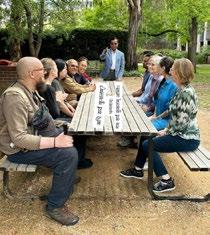


On Netaji Subhas Chandra Bose's birth anniversary in January, some cherished memories of his historic home near Darjeeling

IBY TORSHA SEN
n 1999, when I was six years old, the decaying remnants of history came alive in an unusual way.
My father, the Sub Divisional Officer (civil) of Kurseong – a quaint little town in Darjeeling district – was tasked with overseeing the restoration of a stately hillside residence steeped in the legacy of India’s freedom struggle. This wasn’t just any house, it was the Kurseong home of the Bose family, where Netaji Subhas Chandra Bose had been under house arrest in the 1930s. The bungalow belonged to his brother, freedom fighter Sharat Chandra Bose, and though it had passed out of family hands in 1996, the West Bengal government seized it in 1997 with plans to transform it into a museum. As a young adult, I learned that Netaji lived in this house intermittently between 1922 and 1939 – including seven months of house arrest. He dispatched many essential political letters from this region, letters to his wife Emilie, and during his house arrest, secret instructions to freedom fighters sent via the chowkidars (guards).

The house - located at Gidda Pahar areaserved as a retreat for the Bose family. There is even a picture of Netaji during a morning stroll by the nearby hill spring at Paglajhora.
When I first saw the house, it was a shadow of its former self. My father would take me along on his site inspections, and I can still recall walking into that dilapidated bungalow for the first time. The scent of damp decay permeated the air. The floors groaned under our steps, as if lamenting the passage of time. Old family furniture lay scattered, its wood warped and broken. Rotten linen, decomposed documents, and black-and-white photographs, some barely recognisable, lay in forgotten corners. For a child with a wild imagination, it was equal parts eerie and enchanting.
With the restoration underway, our home became an unexpected extension of this historic project. Due to space constraints, all the salvaged furniture was moved to our terrace. For months, our mornings and evenings were filled with the sound of carpenters chiselling away at the damaged wood and woodcarvers meticulously recreating ornate patterns. I would sit beside them, watching as decayed ledges were stripped away and intricate designs were restored with painstaking precision. It was as though the past was being reborn


piece by piece, right before my eyes.
Back at the Bose mansion, the scale of work was monumental. The roof - once sturdy enough to witness history - needed to be rebuilt. Windows were replaced, walls were repaired, and flooring was restored to its original grandeur. Even the smallest detail, like the gable running trim along the roof’s edge, were replicated with an almost obsessive commitment to authenticity.
My father, with his meticulous eye, ensured that no detail was overlooked. His aim was not merely restoring a house; it was to safeguard a fragment of history. Just as the project neared completion in 2000, my father received his transfer orders. We packed up our lives and moved to Kalimpong, another serene hill town, leaving the Kurseong home - and this Netaji House inauguration - behind.
Officially inaugurated on April 23, 2000, it became a museum under the auspices of the Calcutta Museum in 2005. All the letters written by Netaji during his Kurseong days are carefully preserved here, including those to Emilie. Additionally, there are many photographs of Netaji, some showing him with the Bose family. The bed, dressing table, study desk, and armchair used by Netaji are also on display. A camellia tree planted by Sarat Chandra Bose in 1934 still
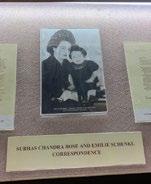
stands as a living testament to the past. My father never returned to the site, perhaps out of a sense of detachment fostered by years of government service, where projects are left behind like milestones on a long journey. It wasn’t until early 2023 that this chapter of our lives resurfaced in a poignant way. My father, now retired, decided to visit the restored Bose home after 23 years (see pic, below, extreme left). From Kolkata, he made his way to Kurseong, camera in hand. When I received his WhatsApp images here in Sydney, I was struck by how much had changed - and how much hadn’t. The house now stood as a proud museum, its walls alive with stories of Netaji’s indomitable spirit. Yet, in the meticulous woodwork and the familiar gables, I could see the echoes of those days when history was reborn on our terrace.
The restoration of Netaji’s home wasn’t just a professional assignment for my father or a childhood memory for me. It was a bridge between the past and the present, between the grandeur of a freedom fighter’s legacy and the quiet persistence of those who work behind the scenes to preserve it.
And in that connection, I’ve come to realise, lies the true power of history - not as a relic of the past, but as a living, breathing force that shapes our present and inspires our future.



Sydney artist and two-time Archibald finalist Kirthana Selvaraj’s painting of the Matildas will be transformed into a giant mural at Accor Stadium

IBY KHUSHEE GUPTA
n a striking fusion of art and sport, IndianAustralian artist Kirthana Selvaraj has created a painting that captures the power and spirit of the Matildas during their remarkable journey in the 2023 Women’s FIFA World Cup.
What started as a commanding tribute is now being transformed into a 57-metre immersive mural at Accor Stadium’s Cathy Freeman Stand. This monumental piece promises to leave a lasting impact in the hearts of a sports loving nation.
Kirthana’s work channels the energy, movement, and power which defined the Matildas’ performances and won over the nation during the international event. Inspired by the sheer force of the players, Selvaraj was successful in evoking a sense of dynamism and energy in her work.
“More than just getting their faces right, I wanted to capture their presence – the power of their bodies in motion,” she explains.
The use of bold colour and expressive brushwork was central to her creative process, as she sought to embody the intensity and energy that the Matildas brought to the world stage. To enrich her approach, Kirthana also incorporated colour studies that referenced Cathy Freeman’s iconic Olympic suit, drawing on the symbolism of those
vibrant hues to honour Freeman’s pioneering role in women’s sports.
Kirthana’s background played a slight role in shaping her approach to this commission.
In a nod to her own Indian heritage, to which she remains deeply connected, Kirthana brought in the positivity and strength that she has always associated with rangoli art.
“Bringing bold colours into the piece felt like a way to connect with my heritage and represent the women who lead this space,” Kirthana reflects.
She also adds that her identity as a queer South Asian woman gave her a unique perspective on representation. “It’s about telling stories from different lenses and creating visibility in spaces that don’t always include people like me.”
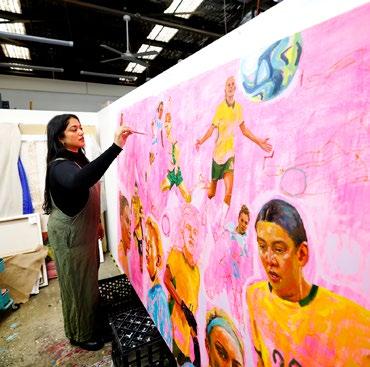
The 2023 Archibald Prize finalist finds inspiration in Matildas captain and star player Sam Kerr, whose Indian heritage comes from her father, hailing from Kolkata. Seeing Kerr dominate on the global stage as one of the best footballers in the world reinforces her
belief that representation matters, and that South Asians can thrive in their respective fields at the highest level. Kirthana Selvaraj is positive that the international situation Kerr currently finds herself in, will not diminish the
“I want people to feel like they’re stepping into the painting, not just observing it – it’s about feeling it.”
nation’s love for her.
What was initially a studio painting now takes on a new life as it is adapted for Accor Stadium’s 57-metre-long projection. Kirthana describes the experience as surreal –witnessing her artwork expanded to monumental proportions. The projection will allow thousands of viewers to experience the painting in a new, immersive way, surrounded by the energy of the stadium.
“I want people to feel like they’re stepping into the painting, not just observing it,” Kirthana shares.
“It’s about creating a connection with the work, making it more than just something to look at – it’s about feeling it.”
As a statement of representation, power, and the importance of visibility, Kirthana hopes that audiences will feel a collective sense of pride, not just in the Matildas’ achievement, but in the ability of art to transcend traditional spaces and reach new communities.
“The Matildas represent so much more than football,” Kirthana explains. “They symbolise a larger cultural shift. I hope this mural inspires people to pursue their passions and feel seen, just like the Matildas do for so many.”
Kirthana Selvaraj’s art is a powerful tribute to women in sport, the strength of the Matildas, and how sport and art combined can empower communities by reaching larger audiences.

AMRIT GILL is an arts and cultural worker with over 20 years of experience, including as Director of International Development at Creative Australia, and Artistic Director/CEO of 4A Centre for Contemporary Asian Art. She is currently an Advisory Board Member for Centre for Australia-India Relations (CAIR) and Creative Project Lead at City of Melbourne.

Where does soft power such as the arts sit within the IndiaAustralia relationship and how is this evolving?
At CAIR, we have a strategic plan that has four key pillars to it. Some of those pillars are more hard drivers of an economic and bilateral relationshipbusiness and trade, policy dialogue. Our pillars that are around soft power are the ones around diaspora engagement and arts and cultural engagement. Those are really about how we understand each other; when we better understand who we are, the depth of our diversity and our complexity, all those other harder parts of the relationship with regards to economics, trade, thought leadership, policy, defence cooperation, health cooperation, all of those come easier because there's a level of trust and understanding there already. Quite often arts and culture is the beginning point in a relationship, and it's the thing that needs to endure because it's the thing that actually helps us connect on a level that's not so transactional. It’s about sharing who we are with each other.

What’s something people don’t know about arts management roles?
the purpose?
That's not necessarily the approach everyone will take, but it's an approach I've always taken because I've always felt that art doesn't exist in a vacuum. There is obviously that innate need to create that artists have, but for it to have impact in the world it needs to connect with people. So for me that's the most interesting part about arts management... But it is tough. It doesn't pay as well as it should. It's hard to crack.


kinds of ideas or concepts that they're exploring through their work.

I think a lot of people go into the arts because it seems like it might be an exciting and sexy career option and, in many ways, it is, because you work in the space of ideas - that's what attracts me. I'm not a maker myself so being able to support artists and creative organisations to realise that has always been a driver for me. But it is a lot of admin, and it's a slog. In social and public spaces, [art and artists are] seen a little bit as window dressing…they're not thought of as essential elements to our lives, but you notice [them] when they’re gone. Because of that, when you’re in a role like mine, it's a constant positioning of why it's important, constantly going back to why - what's the impact? What's
For me, curating or programming is essentially project management. But the ideas side of it is thinking about what sort of story you want to tell or what journey you want to take. In the programming and curatorial work that I've done previously, it usually starts with being interested in a particular story or a particular idea, and then how that might flesh out with artists responding to that. Or if you’re working with just a single artist, it's about having a specific interest in their
Sometimes it’s [programmed] because it's important to tell socially or sometimes it’s because it’s amusing, or whimsical, or has a sense of wonder about it. Or sometimes it's because it's just beautiful. There's lots of different approaches that people take; for me, I'm very interested in how people who interact with the work can find a way through [it] even if it's not to their taste. You don't necessarily have to like everything that's put in front of you, but if you [can] find a way to have a response to it, then that is what I look for.

What's something you're currently listening to/reading/ playing/watching?
I just finished a book called ‘The Singularity’, it’s by a Swedish-Kurdish writer Balsam Karam. I read mostly nonAnglo writers because I want to hear what they have to say, and I saw this in my local bookshop; it’s a translated work. It starts with an assumption of something terrible having happened, but you don't really know what. What you're doing is you're reading the story of displaced people in a very privileged context, and it's quite confronting, but it's also so beautifully written.

The other thing, and I picked this up when I was in India recently, is I started watching this reality show. It's called Splitsvilla, on MTV India - it's absolute trash and completely deficient in any kind of intellectual nutrition, but I'm enjoying it.

What’s a word that you like in a South Asian language, and what does it mean?
One of my favourite words is ‘shabash’. My grandparents would say it in a very loving way, with a head pat.

And finally: Soan Papdi or Papdi Chaat? Papdi Chaat. It’s so crunchy and yummy.
SUMATHI KRISHNAN speaks with Acharya Ratna RAVI M RAVICHANDHIRA OAM, who founded the Academy of Indian Music and Cultural Studies (AIMCS) four decades ago in Naarm, Melbourne. An accomplished mridangist, he is also recognised as a great patron of the Indian classical arts in this country.

What is the future of Indian classical arts in Australia compared to other countries?
Unlike 42 years ago when I arrived in Australia, today a thriving ecosystem exists amidst a growing South Asian diaspora here, offering an ideal foundation for cross cultural works. Independent organisations nurture and uphold pure Carnatic traditions with the involvement of second and third generations today. Over the past four years, AIMCS in partnership with Apsaras Arts Singapore and Monash University Performing Arts Centres, has launched IPAC performance industry programs for next gen, involving mentorship and lecdems from top-class Carnatic professionals of Australia and India. Today artists can engage with luminaries in the field.

How has receiving the Order of Australia Medal (OAM) impacted your work in this field?
Receiving the Medal has given recognition to a lifelong dedication to the arts. The award has been a catalyst to improved access enabling direct engagement with renowned artists and stakeholders in the arts sector, increased recognition for my work in Australia and abroad. That said, the OAM status does not grant any automatic privilege or right to funding.

Your views on how Australia's festival and program funding models compare to others, in general? Grant applications should be assessed strictly on merit, but assessors often lack the expertise to evaluate applications from diaspora communities. Without critique by qualified experts, poor funding decisions persist. There is a tendency to fund

glamorous projects, over long-term works requiring years to mature.
Unlike festivals such as Cleveland, Margazhi, and Jaipur Lit Fest, Australia lacks Indo-Australian funding, private sponsorships and philanthropic support, all crucial for classical arts development.
Privately funded projects, such as those by Guru Kaaraikkudi Mani, took 5–10 years to cultivate. I introduced Mani Sir to esteemed jazz musicians like Paul Grabowsky AO, Sandy Evans PhD (Music), and Dr. Jonathan Dimond, PhD (Music). Similarly, Bharatanatyam exponent Rajeswari Sainath PhD and her student Vaishnavie PhD spent over five years mastering laya principles, achieving groundbreaking footwork while preserving expression and abhinayam.

Tell us about your two sons’ trajectory in Carnatic arts.
My sons Sai-Nivaeithan and Sai-Sarangan Ravichandhira, have been playing mridangam spanning 18 years from the age of 12. They are consistently performing at the prestigious Margazhi Utsavam in Chennai. They have benefited from the mentorship of Guru Kaaraikkudi Mani, principally in helping raise their performing standards. Other Indian legendary artists have also guided my sons.

What advice would you have for young mridangists?
Other than mastering rhythmic precision, clarity in fingering, focus on learning to complement whilst accompanying, cultivate manodharma, develop stage experience, and collaboration. Understand instrument chemistry, correct posture, reverence for Gurus. Active listening and engagement with fellow-artists
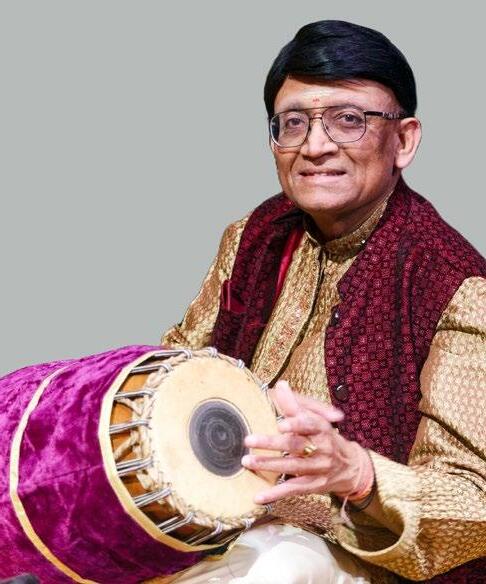
is most essential for artistic synergy and excellence.

List some of your most successful IndoAustralian ventures.
Amidst many, foremost would be the Indian Music Tour of Australia and NZ (2001), a percussion ensemble, curated by me, in which I also performed, featuring the late Ustad Zakir Hussain and legendary Ghatam maestro Vikku Vinayakram. This remarkable tour took place at three mainstream arts centres in Auckland, Melbourne and Sydney.
The tour also showcased exceptional talents of Mandolin wizard U. Shrinivas, his brother U. Rajesh, and violinist Vidwan S. D. Sridhar, creating a mesmerizing
blend of melody and rhythm.
The other two ventures have to be Lalgudi’s Melodies (2015), a suite of DVDs and CDs, blending Bharatanatyam jathis and compositions, created in collaboration with my wife Narmatha Ravichandhira OAM, and the dance musical production Nature, the Great Teacher – A Dance Musical (2018) conveying an environmental message.

Future events from your platforms we could look forward to?
The Academy will be holding the 40th anniversary of the prestigious Melbourne Trinity Heritage Festival, 4-6 April 2025, a festival providing opportunities for gen next artists to display their excellence.
Ravi Ravichandhira’s passion for the development of Indian arts in Australia has led to the establishment of the high profile annual Indian Performing Arts Convention (IPAC) in consortium with Monash University Performing Arts Centres and Apsaras Arts
Singapore. He is acclaimed for integrating South Indian art into the Australian music scene, collaborating with diverse musicians including members of the Australian Art Orchestra and Indian stalwarts such as Kaaraikkudi Mani, and has played a key role in fostering new collaborations both in Australia and internationally.






Inspired by the jaunty sound of indie rock mainstays, Melbourne and Adelaide-based Indie(an) Tushar Singh is diversifying a predominantly white genre

YBY LAKSHMI GANAPATHY
ou’d be forgiven for thinking Indie pop artist Tushar Singh, known by moniker TUSHAR, was born and brought up in Fitzroy.
Chatting to him in his leafy back garden on a languid afternoon in December, he tells me excitedly about exploring local markets, his loose fit skater shirt and long black hair tucked under a vintage style baseball cap blending right into the cool, indie sensibilities of Melbourne’s inner north.
Of course, like so many of us young South Asian Australians who’ve grown up on a diet of Coldplay, Tame Impala and Two Door Cinema Club, Singh has spent a long time feeling out of place, in music and in life.
A middle child of four siblings, Singh grew up in Singapore with the dulcet tones of Lata Mangeshkar and Sonu Nigam drifting around the house. When he was six, his family moved to Adelaide’s east, opening one of the state’s first Singaporean Indian fusion restaurants, Unley Rd’s Raj on Taj; still a family-run business, his parents are now staples of the burgeoning Adelaide Indian community. Meanwhile, as one of the only brown kids
at his primary school, Singh started to notice the dissonance between what he heard inside and outside of home. It didn’t take long for the ‘Voice of the Millenium’ to be drowned out by the sounds of a new millennium - Kylie Minogue, The Veronicas and Guy Sebastian.
“My taste started to change…Everyone was like ‘Tush, you’re such a white boy now!’ It was funny, I never had any ill intent, but I could feel that change in my mind - I just wasn’t interested in listening to that music anymore, Hindi music is not really my style, I want to venture out and do more things. At that age, I think I also wanted to maybe impress my friends, or I guess, social acceptance.”
Then came the biggest influence on his sound, Two Door Cinema Club.
“I was like, 14, 15, I remember a sleepover with a friend, we were buzzing on heaps of sugar…I had MTV playing and suddenly I heard the intro to ‘Undercover Martyn’. We both didn’t say a word and watched the whole clip, and after I was like, ‘Dude, that was so good!’”
“I just really fell in love with that indie sound, you know, it got me dancing, got me feeling happy. Like, how good is that [sound], it just always makes you feel like you want to be doing something, and it’s just so catchy.”
TUSHAR’s latest tracks harken back to this golden age of indie; bouncy, bright, danceable,
Singh’s airy vocals painting pictures of anxious first lovers, enigmatic blue-eyed charmers, afflicted friends and aloof companions who would all equally be at home in a Two Door song.
Together with co-producer Benny TamblynMorrow, their most successful songs, including ‘Sadie, Why Don’t You Love Yourself’ and ‘In Our Own Backyard’, have almost 100k Spotify streams, with ‘Peaches and Wine’ featured on Triple J and Triple J Unearthed.
As one of the few South Asian artists in a genre of mostly white, male antecedents however, Singh is aware he’s an outlier, certainly too at a time when so many South Asians are finding voice in Hip Hop, Spoken Word and RnB styles.
“The style of music I’m making is still very much dominated by white Australian musicians; for me, it’s how do I fit into this scene and culture as an Indian diaspora artist that’s writing the same music, and how do I feel comfortable in that. No one’s mean to me and stuff - more that I can’t help feeling like the odd one out.”
He tells me about playing to a majority South Asian crowd at SXSW Austin, an experience that’s profoundly affected him.
“It was the turning point for me. They were there, for us. I was so taken aback; I’ve never felt that in Australia, I don’t really see anyone from my culture at my gigs. I remember
finishing the show and being like, ‘thanks for coming, but how did you know about this?’ and they said, ‘we saw your name, Tushar, on the lineup, and we knew you were Indian’.”
“Turns out they have a community that pushes South Asian artists breaking into the Western music scene, and they all go to gigs together. I called my mum and was like ‘you’ll never believe what happened’ – it just opened up this world for me.”
Since then, the self-described ‘Indie(an)’ has been inspired to connect with and advocate for other South Asian artists; recently, he appeared on the lineup for SXSW Sydney’s ‘+91 Calling’ festival, and his Melbourne ‘Feels Like a Start’ EP gig was co-headlined by Sri Lankan singer-songwriter Githmi, and Indianled dream pop outfit Manorism.
But has he ever thought of swapping ‘Sadie’ and ‘Arthur’ for ‘Suhani’ or ‘Akash’?
“That’s something I’ve been wanting to dive into; I’ve been talking to friends who speak Punjabi or Hindi and I’d love to get them to sing on a track or teach me some words. I want to bridge that gap of having language in songs but still make it super fun and indie – I wanna see them singing the words back to me, I want them to understand it.”
He grins, energised. “Can you imagine a song like that popping off in India or even in Singapore?! It’ll open so many doors, not only for me but for other people.”
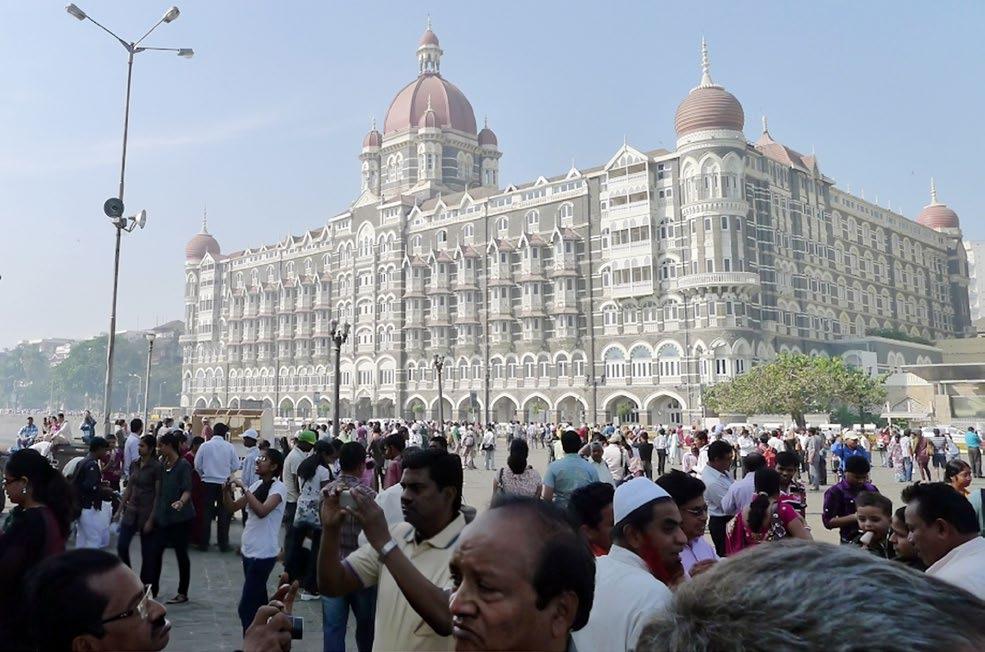


A recent visit to India’s economic powerhouse and cultural hub rekindles an early fascination with the bustling metropolis.

BBY SANDIP HOR
ombay captivated me the instant my train from Calcutta approached the expansive platforms of the splendid Victoria Terminus Rail Station. The architecture of this Britishdesigned structure held my attention, a fascination that persisted as our black and yellow Fiat taxi maneuvered through the lively city traffic, occasionally overtaking red double-decker buses. We passed by numerous colonial buildings, a fountain at a five-way intersection, and a lush yet dusty area where cricket was being played on several pitches before reaching our lodging, Chateau Windsor guesthouse located in Churchgate.
Upon entering our room on the fifth floor, I rushed to the balcony, to be greeted
by the warm sea breeze from the Arabian Sea. Having seen photographs before, I recognised the semi-circular roadway along the coast as Marine Drive, bustling with vehicles, some of which I had never encountered in my hometown Calcutta. Somewhere in my line of sight, there was a cricket match in progress - the cricket enthusiast in me knew immediately this was Brabourne Stadium. While the towering buildings in the distance seemed to call to me, the vibrant sounds from the street
below encouraged me to join the crowds visiting the trendy shops and restaurants. The urban landscape appeared strikingly different and modern compared to Calcutta. It was enough to enchant a teenager, leading to an enduring love for the vibrant city that unfolded before me. This enchantment has never waned.
It was then 1969, and I was a high school student enjoying a vacation with my parents. Upon completing my education, I began my working life with a German
“The urban landscape appeared strikingly different and modern compared to Calcutta. It was enough to enchant a teenager, leading to an enduring love for the vibrant city that unfolded before me."
multinational corporation headquartered in Bombay. This role necessitated frequent visits to the city, which further fuelled my love affair with the city.
I quickly became accustomed to the efficient public transportation system, particularly the local trains and buses. I enjoyed shopping at Akbarallys, perhaps India's oldest department store, which offered a diverse selection of products from clothing to spices. I explored the stylish boutiques along Linking Road in Bandra, attended Bombay soccer league matches at Cooperage Stadium, and encountered famous Indian cricketers savouring their fresh lime sodas at the Cricket Club of India. I also spotted Bollywood stars, including my idol Dev Anand and Sharmila Tagore, at airports and in the lobbies of five-star hotels. My culinary experiences included vada pav from street vendors in Dadar and chicken patties at Jimmy Boy as snacks, sweet tea with Shrewsbury biscuits at Parsi cafes, and Bombay Pilsner beer in charming local pubs. Late-night visits to Rustomji’s ice-cream parlour at Churchgate became a routine, and I marked several restaurants as my favourites, including Flora at Worli Sea Face, Talk of the Town on Marine Drive, Copper Chimney at Worli with its open kitchen, and Delhi Durbar at Colaba, among many others that still linger in memory. I was gradually acclimatising to a lifestyle and comforts that were distinctly different from those in Calcutta, and my affection for Bombay deepened, leading me to contemplate a move there.
However, as the saying goes, man proposes, and God disposes.
In 1984, I moved to Sydney, Australia, where I have since established deep roots. Nevertheless, my affection for Bombay has remained steadfast.
After nearly four decades, I returned to the city to revisit cherished memories.
As expected, several changes greeted me. I was aware of the name change, therefore, arriving in Mumbai instead of Bombay did not surprise me. However, I was taken aback by the magnificence of the newly established Chhatrapati Shivaji Maharaj International Airport and its remarkable efficiency of operations. Dutyfree shopping done, immigration cleared, and luggage retrieved, I found myself in the car park in nearly half an hour - not always possible in Sydney or London.
Since the eighties, the population of Mumbai has increased from four to nearly twenty million, which means massive infrastructure development in every direction. Driving me from the airport to Churchgate via the newly built Sea Link and the Coastal Highway, my driver explained that these road networks have cut down travel time from the airport to South Bombay drastically.
We whizzed past Antilla, businessman
Getting There Fly Qantas (www. qantas.com) and their code share partner Indigo (www.goindigo.in) to reach Mumbai via Bengaluru.
Accommodation Chateau Windsor Hotel at Churchgate (www. chateauwindsor.com)
Mumbai City Tour Eastbound Group (eastboundgroup.com)
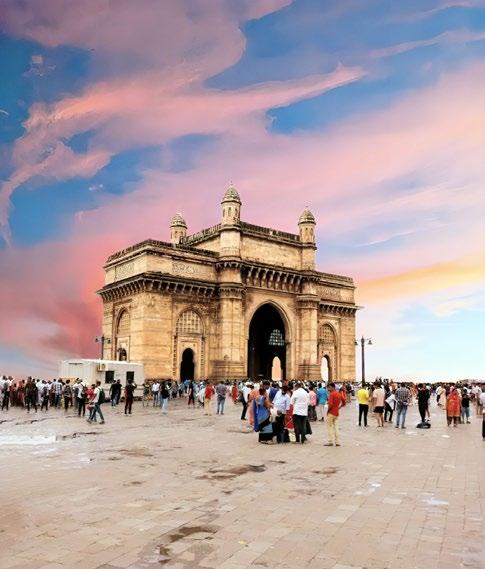
Mukesh Amabani’s 27-storey mansion which now dominates the seafront location as a bizarre addition to the landscape. Motivated by nostalgia, I chose to stay at the same guesthouse of my youth, now transformed into a 65-room hotel of the same name. Upon entering my room, I hurried to the balcony. While the warm breeze from the Arabian Sea was familiar, I noticed that Marine Drive was now congested with an increased number of vehicles. The outlines of the distant skyscrapers appeared hazy due to pollution, and Brabourne Stadium stood empty, as cricket had relocated to the Wankhede. The vibrance of the street below seemed significantly diminished. I was disheartened to see that the area had lost its former charm, with renowned restaurants such as Talk of the Town, Kamling, and Purohit all shuttered, the entrance to the Cricket Club of India in a state of disrepair, and the footpath littered and cracked. Although Rustomji’s ice cream parlour still operated, it appeared worn and uninviting. A local resident remarked, “The lively spirit of Bombay has moved from this part of the city to Bandra Kurla Centre, commonly referred to as BKC.” Regrettably, due to a lack of time, I limited my activities to the confines of South Bombay, which prevented me from exploring that area of the city thoroughly. The heart of South Bombay is arguably Colaba, characterised by the old houses, trendy shops and street markets, famous eateries like the Leopold Café, and the sea facing Taj Mahal Palace Hotel, which overlooks the Gateway of India. The precinct has always been heavily crowded, no exception to that four decades later. This location serves as the departure point for boats heading to World Heritage listed Elephanta Island, renowned for its seventhcentury rock-cut temples. One of the city's premier attractions, it captivates with its artistic and architectural splendour.


At Colaba and its surrounds, I had the opportunity to dine at Shamiana, one of the oldest and most renowned restaurants within the Taj Hotel. I also enjoyed Irani Chai, chicken patties and Shrewsbury biscuits at Jimmy Boy, a venue that has been offering authentic Parsi cuisine since 1925.
The Taj, I could not help observing, is no longer exclusive to the city's elite as it once was; it now attracts a significant number of the emerging middle class. This shift reflects the current economic growth in India, which has broadened the middle-class demographic. However, it was disheartening to witness the decline in the prestige of a once-revered establishment. My previous trips to Bombay felt incomplete without indulging in kebabs at the Copper Chimney, which now has multiple outlets across the city. I visited their Kala Ghoda outlet, but I found that neither food nor atmosphere resonated like they had in the past.
As a returning tourist, Mumbai’s numerous attractions fascinated me - the Hanging Gardens in Malabar Hills; Haji Ali Mosque set against the backdrop of the sea; lively Crawford Market, and Victoria

I also explored Dhobi Ghat (an openair laundry that has been in operation since colonial times), the Prince of Wales Museum, and a series of colonial-era buildings that create a fairy tale ambiance when illuminated at night. Despite various transformations, I found the city to be just as appealing as it had always been. My love affair with Mumbai, nee Bombay, continues.

From epic showdowns to scandalous secrets, KHUSHEE GUPTA rounds up February’s must-watch releases. Get ready to stream, binge, and hit the cinemas!
Wedding season just got wild! You’re Cordially Invited is officially out, and trust us – you don’t want to miss this RSVP! Reese Witherspoon and Will Ferrell bring the chaos in this hilarious comedydrama when two weddings get double-booked at the same venue. Spoiler: absolute mayhem. Adding to the fun? The amazing Geraldine Viswanathan as Ferrell’s daughter Jenni, who’s just trying to survive the madness.
Released 30 Jan


Cricket’s fiercest showdown is back! This documentary dives into the passion, history, and drama of this legendary clash. Featuring icons like Virender Sehwag, Sourav Ganguly, Sunil Gavaskar and Shoaib Akhtar, the documentary unpacks unforgettable matches, behind-the-scenes stories, and the emotions that make this rivalry bigger than the game.
Released 7 Feb

Ajith Kumar headlines this high-octane Tamil action-thriller directed by Magizh Thirumeni. With a gripping storyline, intense action sequences, and Ajith’s signature screen presence, Vidaamuyarchi promises an edge-of-the-seat cinematic experience. Backed by Lyca Productions, this film is set to be a must-watch for Tamil action fans!
Released 6 Feb




The Mehta Boys explores the complexities of fatherson relationships within an Indian family. Starring Boman Irani and Avinash Tiwary, it delves into themes of identity, fatherhood, and generational conflict with warmth and humour. Directed by Namit Sharma, this release promises an emotional and relatable story, perfect for fans of family dramas.
Released 7 Feb
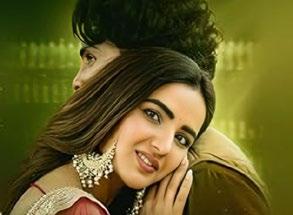
BADNAAM (In cinemas)
A gripping Punjabi crime thriller about power, betrayal and revenge starring Jasmin Bhasin and Jai Randhawa. If you love dark, gritty narratives, this one should be on your radar.
Releasing 28 Feb

Starring Sanya Malhotra, this is a poignant drama about a married woman’s journey to rediscover her identity while navigating the daily demands of life in the kitchen. Receiving a standing ovation at the Indian Film Festival of Melbourne (IFFM), Sanya’s stellar performance earned widespread praise. Directed by Arati Kadav, it’s a story of self-discovery and resilience.
Released 7 Feb

Glamour, grit and a whole lot of secrets – Dabba Cartel is a stylish thriller set in the opulent 1960s Mumbai, where five housewives are more than they seem. Between managing households and running a high-stakes secret cartel, they navigate ambition, love, friendship, and betrayal in a world where power comes at a price.
Releasing 28 Feb

A fun-filled romantic comedy perfect for Valentine’s season! With a fresh cast including Junaid Khan and Khushi Kapoor and a lighthearted premise, Loveyapa explores the chaos and charm of modern love.
Released 7 Feb

Himesh Reshammiya returns with a full-blown masala entertainer. Expect over-the-top action, wild dialogues, and signature Himesh swag in this larger-than-life Bollywood spectacle. Plus, Prabhu Deva dons the acting hat once more!
Released 7 Feb

Valentine’s Day romance with a twist? Count us in!
This rom-com action movie, starring Pratik Gandhi and Yami Gautam, promises a mix of laughter, drama and newlywed moments – perfect for a cozy date night in.
Released 14 Feb
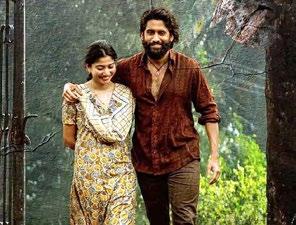
An intense Telugu action-drama starring Naga Chaitanya as a fisherman from Srikakulam who is captured by Pakistan’s forces. It highlights his fight for survival against overwhelming odds while Sai Pallavi adds emotional depth to the story, making it an unmissable watch.
Released 14 Feb

A grand historical epic starring Vicky Kaushal and Rashmika Mandanna, this film brings the story of Chhatrapati Sambhaji Maharaj, son of Chhatrapati Shivaji Maharaj to life with breathtaking battle sequences and compelling performances.
Released 15 Feb

MERE HUSBAND KI BIWI (In cinemas)
A laugh-out-loud Bollywood comedy with an absurd yet intriguing love triangle. Starring Rakul Preet Singh, Arjun Kapoor, and Bhumi Pednekar, this one is bound to deliver some (not so) family-friendly fun.
Releasing 21 Feb

(In cinemas)
A heartwarming tale of the unique bond between a grandmother, played by Neena Gupta, and her grandson, Mihir Ahuja. Set in the vibrant city of Sydney, it becomes one of the many Indian films in February 2025 that explores relationships, love, culture and generational differences. The cherry on top? A special appearance by Australia’s very own Guy Sebastian.
Releasing 27 Feb
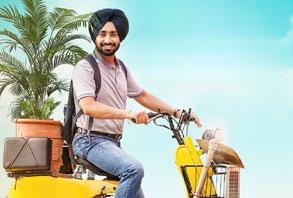
What happens when a man once denied education returns as a teacher determined to change the system? Hoshiar Singh follows the inspiring journey of a passionate educator who challenges outdated norms to revolutionise learning and life itself. Starring Satinder Sartaaj and Simi Chahal, this Punjabi drama is a mix of powerful emotions, empowerment, and thought-provoking storytelling.
Released 7 Feb

Sukhjit Kaur Khalsa OAM is adding the word “Author” to her never-ending list of descriptors, making us wonder whether she ever really sleeps. Her latest book Fully Sikh: Hot Chips and Turmeric Stains gives insight into her experiences as a Sikh Australian navigating through public and private worlds. Who better than Khalsa, who has spent much of her adulthood performing on stage, to explore this duality? Filled with her characteristic wit, it’s a book that promises to make you introspect as much as it will make you laugh out loud, making it a guaranteed February favourite.

Joy Crookes is finally back! After an excruciating three year wait, the Bangladeshi singer dropped her latest single Pass the Salt. Whilst she has retained her distinct vocal quality and RnB musical style in the new single, her cheeky lyrics mark a shift away from her old music. We’ve already been treated to a teaser of her next song Mathematics, released early Feb, where her voice and the strings melt together into a glorious harmony. The new album is guaranteed to be loved by old fans and will be a gateway drug for new ones.

You’re Cordially Invited is a rom-com perfect for some light escapism thanks to its totally bonkers creative choices. A scheduling mishap results in a wedding venue being double booked, leading to Will Ferrell, playing the father of one bride, and Reese Witherspoon, as the steadfast older sister of the other, to engage in a thrilling rivalry. Whilst Witherspoon and Ferrell undeniably steal the show, the film can also be referred to as “that Geraldine Viswanathan film” due to her ability to match Ferrell’s comedic versatility. It suggests that her entry into mainstream cinema is more probable than not.

Craving a fast snack that still has a spicy kick? With jaffles being such an easily customisable food (and of course, superior to regular old toasties), it would be a crime not to make an “indian-ised” version of the snack. Try spicy, flavourful fillings. Matar paneer. Tandoori paneer. Masala aloo. Aloo beans. Baingan bharta. Paneer bhurji. Kheema. Tandoori chicken. Even Pav bhaji. For the oldies, it will be a hark back to the India of their youth. And if the Australia-born kids love it, hey, you’ve got one lunchbox sorted for the week.
WRITTEN BY SRUTHI SAJEEV
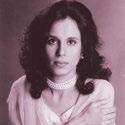
Minal Khona has been reading tarot cards for the last two decades. She uses her intuition and connect with the cards mostly to help people.
The cards say, strike a balance in everything you do this month. Singles may meet someone from their past. Change your perspective and watch how your problematic situations change. Take a break from work before you burn out. Meditate to strike a balance emotionally and to release negative emotions. Stress could bring back an old health condition. Whatever happens this month is preordained, and you may have a spiritual experience that will reiterate the fact. Trust the process and confront your fears.
You draw the card for Pisces, which will enhance your creativity. Some of you may be anxious about the pace at which a relationship moves; be patient. A busy month full of communication on all fronts – work and personal. Your job will fetch good returns moneywise. A new job offer or project is on the anvil. Work on self-help techniques for positive results. The decisions you make this month will work in your favour. Curb your ambition and don’t take on more than you can handle.
Singles may meet someone younger they can fall for. Success is yours at work and in your personal life this month so make the most of it. Take a break and do something you enjoy. Any work involving thoughts and ideas will bring positive results. Good news you are waiting for is coming, especially if it entails a creative project. Help will come to you unexpectedly during any crisis. Everything will come together gradually as a negative situation ends.
Singles will meet someone, but it won’t work because you want something deeper. A past relationship is one you want but your own wrongdoing ended it. Some of you will have a hard time at work but new offers will come your way. Look within to find answers you seek and to address your anxiety. Respiratory problems shouldn’t be ignored. Finances remain steady; you can expect help from a new source. No matter what the crisis, practice doing what is right by everyone.
Some disappointments are meant to teach life lessons. Learn from them and let go - whether it is a relationship or a particular outcome you were hoping for. Singles will not be with someone for the sake of being in a relationship. A marriage could get rocky. Watch out for bowel-related health issues. Be careful with your finances. Your best success comes from applying spiritual lessons to your daily life. Before you take action in any important matter, wait for clarity.
You pick the card for Aquarius in February. This might make you even more practical this month. A rocky relationship will end. Some of you may move or want to do so. Travel delays are predicted but they are to your advantage. Expect disagreements at work. A sudden loss of income could be worrisome. Have faith because every situation and obstacle you are facing will change soon. You will gain clarity after a period of three to six weeks or months.
You pick the card for Virgo, so you might come across as finicky this month. A marriage could end in a divorce. Professionals could be thinking of making a career switch. Go with the flow and be accepting of all the current occurrences in your life. A health problem needs attention as it is impacting your daily activities. A new business plan may fail to take off. Let go of wanting to control outcomes, and let the divine take over.
Those of you who are trying could get pregnant this month. If in a relationship, you will seek more depth. Professionals might want to change jobs to something more fulfilling, creative and helpful to others. Go within and listen to your feelings. Do the same with your body if you have any aches and pains. Money expected could be delayed. An important connection is on the anvil. You will find an outlet that will help you release stress and calm your mind.
Watch out for the red flags in a relationship before you decide to go any further. Their behaviour will make you rethink your level of commitment. Changed perspectives and spiritual growth will help you with your work. Watch your diet to avoid ill health. Get heart checks done for senior members of your family. An investment will bring good returns. A life-changing offer could come your way. The universe is working to improve your life, you have to keep cooperating.
Trust in the higher power for every problem that surfaces this month. A sudden opportunity to make money could come your way. The self-employed could see repeat business and increased profits. One partner could be sacrificing more than the other in a marriage. Take more rest and stay away from those who take more than they give. Let go, and let God guide you even if the circumstances are not to your liking. New ideas need to be put on hold.
You strongly desire to move on from the past but ask yourself what you need to let go of. Express your feelings or a relationship could go bad. Some of you may end a relationship. Respond differently to stop repeating old patterns. Travel due to health reasons is foretold. The self-employed will expand their reach. A financial boost will help change your perspective. Fungal infections could affect you so be careful with your health. Expenses are high this month.
A new business or partnership for the self-employed is on the anvil. Friends will help your business expand and a new deal could bring a bonus. Singles will take a call whether to go forward with a relationship or end it. Some of you might get married. If working too hard, take a break. A trip may not go as planned. Focus on positive ideas and tie-ups that take you closer to your goals. Listen to your heart when in doubt.
HI AUNTYJI
This year, I have decided I am going to be a better wife - by being more loving toward my wonderful husband. But he is making it very difficult for me by his current behaviour. Let me explain. About six months ago, whenever something frustrated my hubby, he would groan and grumble. Mostly to himself. For example, if the dishwasher needed attention, he would open the door, stare at it, groan and then sigh, “Poor Vicky”. Mostly to himself because it meant that it was his job to fix the situation. I would laugh and laugh silently, mostly because it was hilarious listening to his
sighs of self-pity. But lately, his groans are quite audible. If the parking metre is not working, he will get frustrated and groan multiple times quite loudly, like a petulant toddler who can’t get the jigsaw puzzles right. His groans and grumbles are hugely irritating. If a situation is not working for me, for example, the umbrella is not opening properly or the garage door is stuck or the kitchen drawer is not opening or closing, I calmly try to rectify the situation. No theatrics from me. So, Auntyji, how do I get my hubby to stop the drama and tamasha and just get on with it - without the vocal accompaniments? Any advice?

Do you have a question for Auntyji? Email it to info@indianlink. com.au

AUNTYJI SAYS
Oh my calm and resilient little Saraswati, you are the embodiment of all that we should aspire to be. I can feel your frustration - because some time ago, my own hunny, the usually jocular and easy-going Uncleji started doing the same thing. For example the car wouldn’t start - and in addition to the recalcitrant sounds of the engine trying to start, there would be Uncleji, grunting and moaning in symphony with the dying engine. It was like an orchestra of the damned. I put a stop to it by one day reminding him that he was behaving exactly as his mother did when she got frustrated. It put an immediate stop to his naatak.
For you, you can go all out and take the entertaining approach. Next time something is not working, and Vicky is there grunting and groaning in frustration, step in and say “let me have a turn”. Then you must also grunt, groan, grumble at the situation. But you have to take it up a notch and be even louder than Vicky. If he looks at you with surprise and asks what you are doing, then look back at him equally surprised, as though you don’t know what he is talking about. If you do this at least three to four times, I am certain Vicky will get the message.
If he doesn’t, you can always record him. Then play back.
However, if you truly mean it when you say you want to be a more loving wife, then I suggest you let Vicky know that his groans are lacking in grace - and his dignity, even his mardangi - is being compromised, when he carries on like that. He will get the message. All the best!





